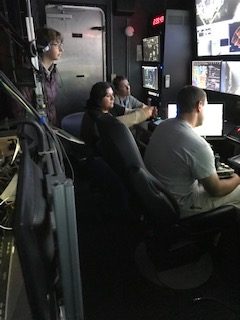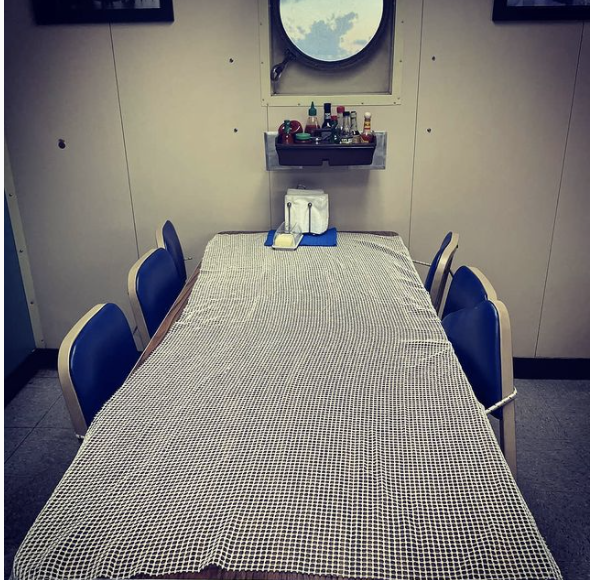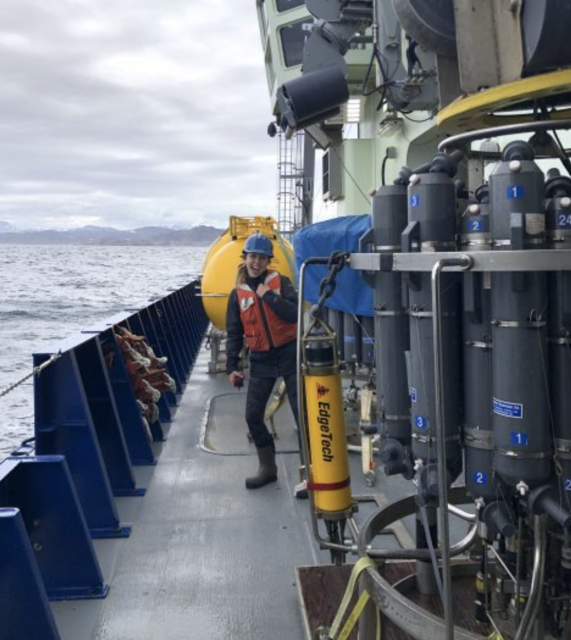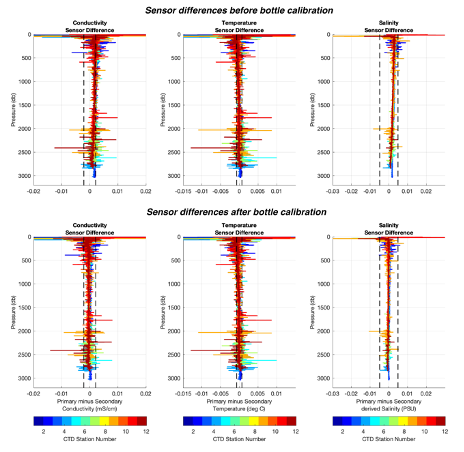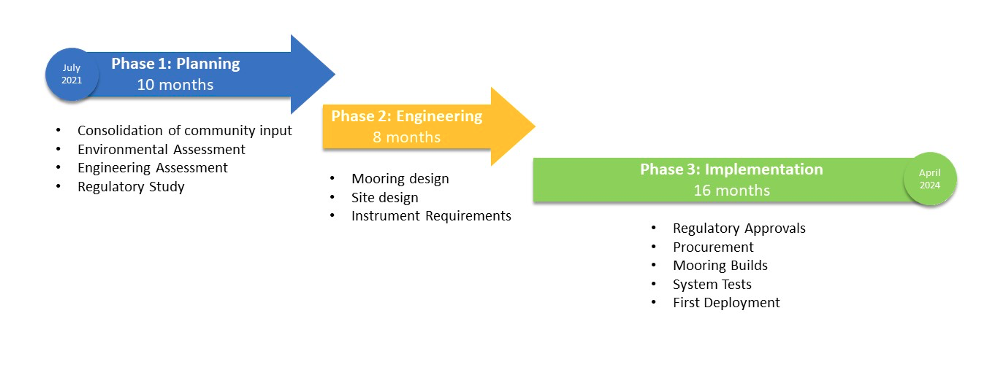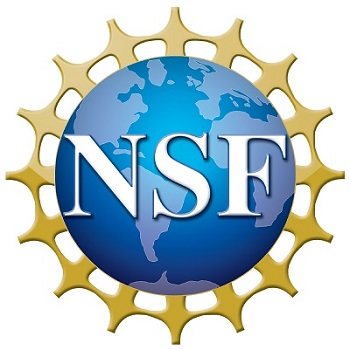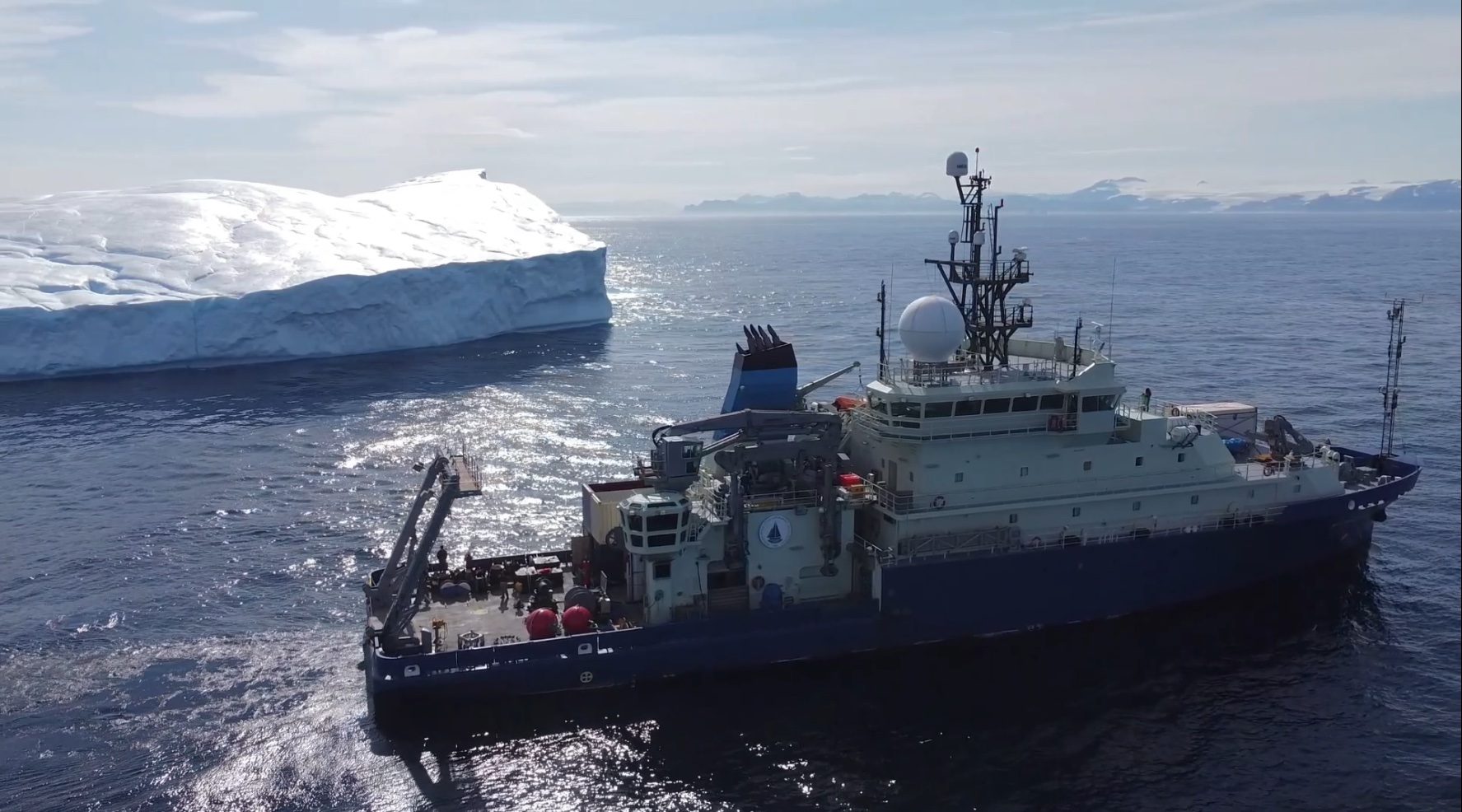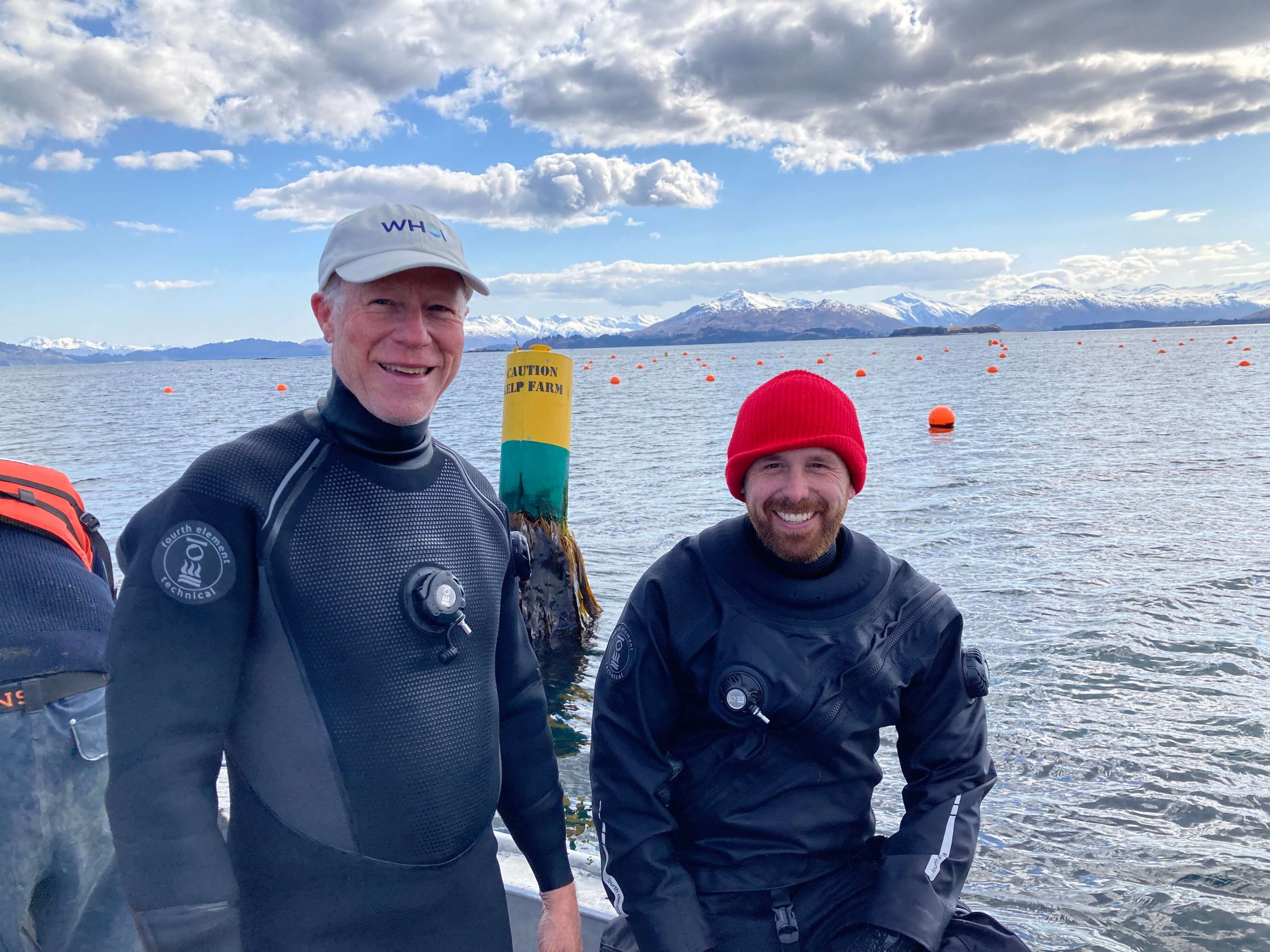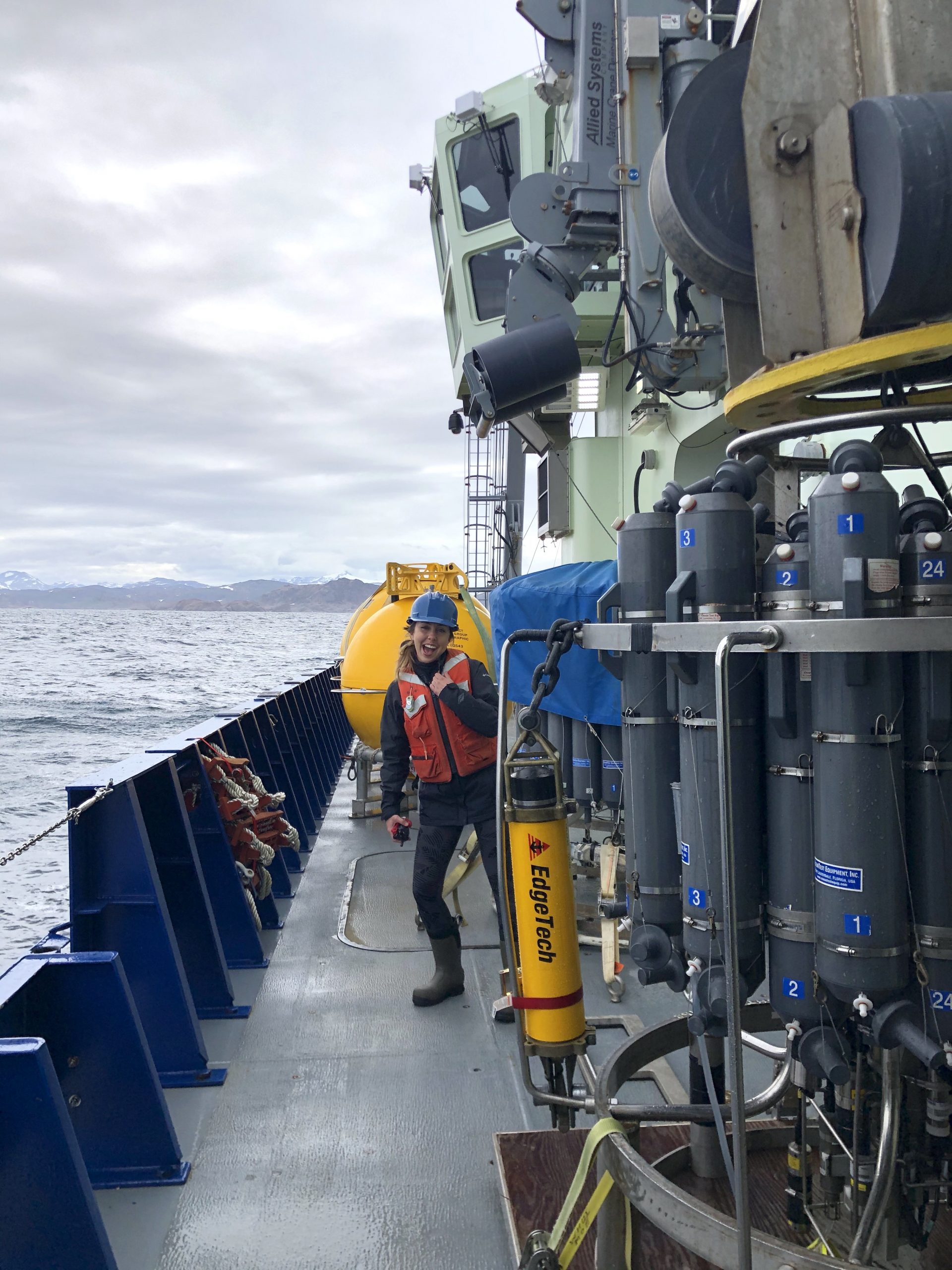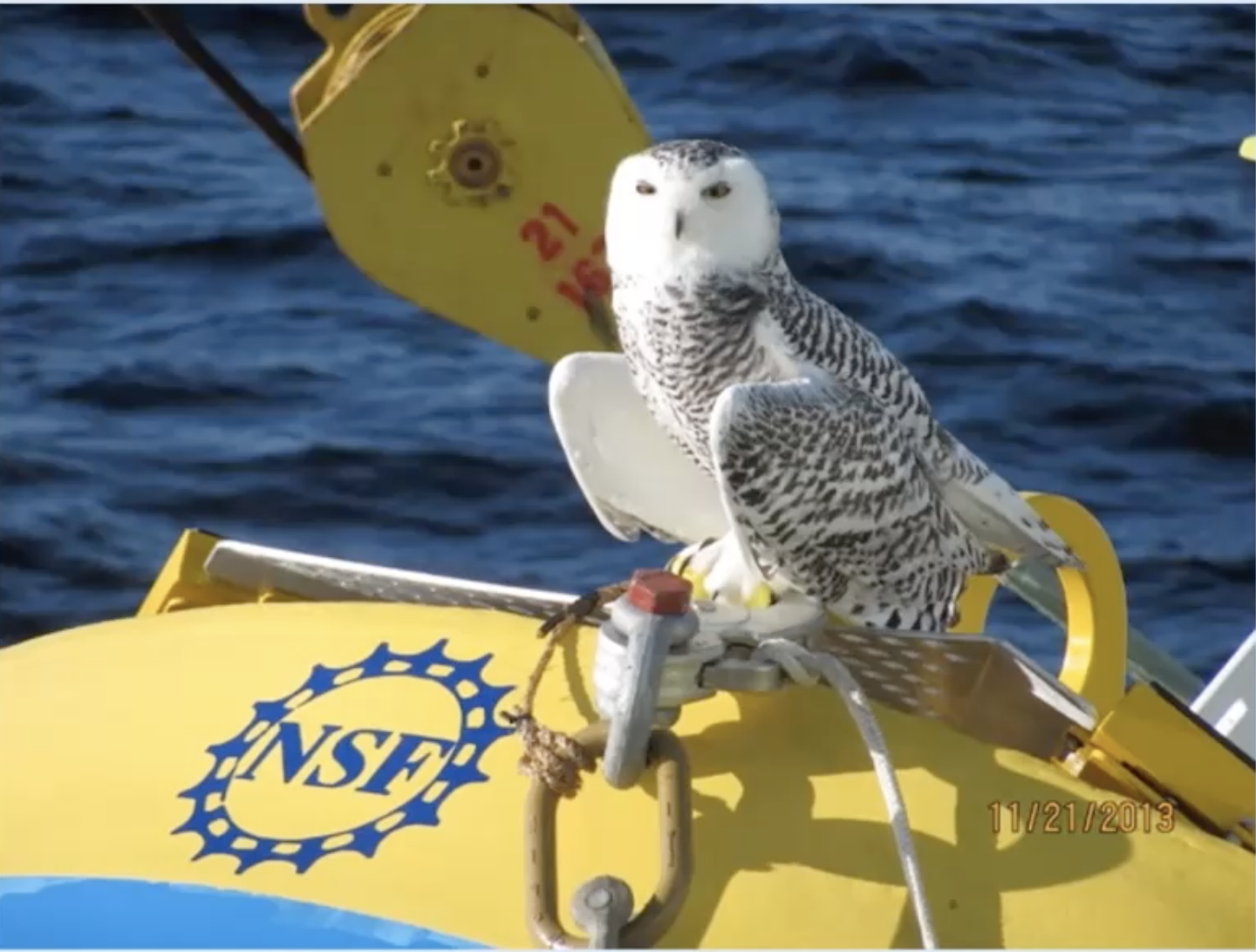Posts by ooistaff
Katie Bigham: From VISIONS Student to Co-Chief Scientist
Katie Bigham feels like her journey with the Ocean Observatories Initiative (OOI) has come full circle. She first visited Axial Seamount as a University of Washington (UW) School of Oceanography undergraduate participant on the Regional Cabled Array (RCA) VISIONS 2014 program when the underwater observatory was being installed. This summer, she returned to Axial Seamount on her seventh cruise, this time as a Co-Chief Scientist.
[media-caption path="https://oceanobservatories.org/wp-content/uploads/2021/10/Katie_V15_byLauren_DSC_0069.sm-copy-scaled.jpg" link="#"]Katie Bigham on the R/V Thomas G. Thompson. Credit: L. Kowalski, University of Washington, V15.[/media-caption]Katie was excited to step into the role of Co-Chief Scientist on the fourth leg of the annual RCA operations and maintenance cruise (VISIONS’21). She previously participated in many other roles on the ship and was looking forward to a new challenge sailing as a Chief Scientist aboard a global class research ship.
Her responsibilities as Co-Chief Scientist included much planning and communication during the round-the-clock operations and numerous remotely operated vehicle dives. “It’s really about keeping everybody who’s invested in the voyage up to date, from the RCA team itself, to the Captain and crew, to the VISIONS’21 students, to the RCA team shore-side,” she says. Katie credits the success of leg four to the OOI RCA team aboard the R/V Thomas G. Thompson and strong shore support. “I felt well-supported in my first time as Co-Chief, and that helped me step up to the challenge,” she says.
Katie says the coolest part of being on the cruise was working with recent UW graduate Katie Gonzalez. She met the younger Katie when she went to visit her school for an outreach event in the far western reaches of the Olympic Peninsula and later mentored her in the lab for a year. “To see her very confidently and competently prepping the osmotic fluid samplers and then sharing with the ROV pilots what the goals of the installation dive were, and what was needed for this instruments deployment within and active vent site was really cool,” she says.
Katie Bigham grew up as the granddaughter of a commercial fisherman and spent a lot of time on the water, but she didn’t know that oceanography was something people studied until high school, when she interned with an oceanography graduate student at UW. The lab was very welcoming to her, and she attended the lab’s summer barbecues and dissertation defenses in between her work helping to culture Arctic bacteria.
After that experience, Katie initially wanted to study geology at Arizona State University, but she decided to stay closer to home and attend UW instead. When she remembered how welcoming the oceanography lab was, she decided to take oceanography classes, and that’s when things started coming together. Early in her college career, Katie took Dr. Deb Kelley’s hydrothermal vents class and came away from it wanting to see the underwater hot spring environments in person and work with Dr. Kelley and the OOI team.
“Deb bringing me onboard as a VISIONS student and then mentoring me through that process was what helped me know I wanted to stay in oceanography,” Katie explains. “I was really inspired by her research and her work with students, and I’d really like to continue in academia because of her influence. I wouldn’t be doing the things I’m doing without all her support.”
[media-caption path="https://oceanobservatories.org/wp-content/uploads/2021/10/20210903_100228_01-scaled.jpg" link="#"]VISIONS’21 Leg 4 students and participants. Credit: M. Elend, University of Washington, V21.[/media-caption]Katie is currently pursuing a joint PhD at the Victoria University of Wellington and the National Institutes of Water and Atmospheric Research in New Zealand. She is continuing with deep-sea science, researching the impact of turbidity currents, or underwater landslides, on benthic communities living in submarine canyons. This work builds on some of the work she did for her undergraduate senior thesis mapping megafauna at methane seeps along the RCA. Katie hopes that her research will be helpful for management of marine protected areas in New Zealand and inform about impacts in other marine canyons, such as those on the Cascadia Margin.
Katie returned to Washington from New Zealand during the COVID-19 pandemic. She has been able to continue her writing and data analyses while abroad from an office within the RCA space. Ironically, thanks to the pandemic, she was able to participate in this year’s RCA cruise.
After she obtains her PhD, Katie hopes to continue her research as a postdoc. “I would really like to bring what I’ve learned during my PhD and my experiences with the RCA back together,” she comments. “I’d love to do a postdoc working with RCA data.”
[embed]https://youtu.be/_YOsgNNLOP8[/embed]
Katie Bigham also played an instrumental role in the production of this video that was a project for the VISION’14 class. It was selected as one of the top ten videos in a nationwide contest sponsored by the Florida Center for Ocean Sciences Education Excellence. The video has been viewed by nearly 38,000 student judges in 1,600+ classrooms in 21 countries.
Read More
Rocky Seas Didn’t Deter Endurance 15’s Success
In spite of rocking seas, a generator in need of repair, and a medical delay, the Coastal Endurance Array team successfully completed its mission to turn the array for the 15th time, achieving all of its science objectives.
Weather conditions in the northern Pacific were less-than-ideal for two of the three legs of the two-week expedition. At one point, winds speeds of 25-30 knots, with accompanying waves of up to 10 feet, caused a weather delay in operations and subsequent alterations in cruise plans.
“While it was comfortable to be aboard the R/V Thomas G. Thompson even in such conditions, sea conditions were borderline for entering or exiting Newport and deploying or recovering most platforms, “explained Chief Scientist Jonathan Fram, who led the 10-member science party. “Fortunately, we had good weather during the first leg of the cruise, which gave us some leeway to address weather-related downtime and other delays during latter legs of the cruise. We were able to switch the order of some activities, delay some deployments, and ultimately got most everything in and out of the water as planned during our time at sea.”[media-caption path=”https://oceanobservatories.org/wp-content/uploads/2021/09/Screen-Shot-2021-09-28-at-5.20.52-PM.png” link=”#”]When seas were calm, the team was able to deploy moorings like this one. After deployment, they headed back to port with a deck full of recovered equipment.[/media-caption]
The team successfully deployed and recovered six surface moorings, four gliders, and two profilers. They also recovered two additional profilers and an anchor from 2020. In addition, the team conducted CTD water sampling and also conducted sampling for researchers with instruments on Endurance Array moorings. The team succeeded in collecting fouling communities growing on buoy panels for researcher Linsey Haram of the Smithsonian Institution and organisms on devices attached to two multi-function nodes for Oklahoma State researcher Ashley Burkett.
While in the roaring sea, the team tested potential instrument replacements and new sampling strategies. They also assessed first-time implementation of technical improvements including a new solar panel frame to prevent sea lions from unplugging the panels, an underwater camera constructed with off-the-shelf replacement parts to ensure longevity and resilience, and a stretch hose from a new manufacturer with a slightly different design than previous versions.
“In spite of having to repeatedly change our plans,” adds Fram, “we were pleased to be able to meet all of the cruise objectives. The ocean in the Pacific Northwest is too harsh for scientists to go to sea often in fall and winter, so it is important to refresh this array of autonomous platforms that will keep recording and delivering data during rough times.”
Read MoreNear Real-time CTD Data from Irminger 8 Cruise (August 2021)
In August 2021, members of the OOI team aboard the R/V Neil Armstrong for the eighth turn of the Global Irminger Sea Array and members of OSNAP (Overturning in the Subpolar North Atlantic Program) onshore are making near-real time shipboard CTD data available.
Onshore expert hydrographer, Leah McRaven (PO WHOI) from the US OSNAP team, is working with the shipboard team to support collection of an optimized hydrographic data product. A special feature of this collaboration is the near real-time sharing of OOI shipboard CTD data with the public. Interested parties will have access to the same CTD profiles that McRaven will be reviewing.
McRaven is sharing her reports here while the cruise is underway:
BLOGPOST #4 (September 13, 2021)
Another OOI cruise is in the books! Now that things have wrapped up and I’ve had a chance to dig into the data a bit more thoroughly, how did we do? In my previous post I reported that the Irminger 8 CTD data looked to be very promising, but I like to include one more step before recommending data to be used for science: carefully considering salinity bottle data.
Salinity bottle data can be used in many ways to support a particular scientific objective or research question. The two that I’ve become most familiar with are 1) to support the analysis of additional bottle samples (e.g. dissolved oxygen) and 2) to provide an additional assessment and calibration of the CTD conductivity sensors. Both applications are necessary when researchers require salinity values more accurate than what CTD sensors are able to provide. However, even if this is not required, it can help ensure that users receive data that are reasonably within manufacturer specifications.
I find it easiest to consider the GO-SHIP approach to bottle data first. Using ship-based hydrography, GO-SHIP provides approximately decadal resolution of the changes in inventories of heat, freshwater, carbon, oxygen, nutrients, and transient tracers, covering the ocean basins with global measurements of the highest required accuracy to detect these changes. For a program like this, 36 salinity samples are taken every CTD station in order to provide an extremely accurate and precise calibration for the CTD sensors. Interestingly, the Irminger OOI array is bracketed by three GO-SHIP repeat transects. While GO-SHIP provides invaluable measurements, drawing a large number of samples can be expensive and time consuming. Additionally, measurements occur on a decadal timescale, so there is a lot of the picture we miss.
One of the research programs that aims to provide a higher temporal and special resolution picture of the North Atlantic is OSNAP. This program has several scientific objectives, but generally aims to quantify intra-seasonal to interannual variability of the Atlantic Meridional Overturning Circulation(AMOC) in the subpolar Atlantic. This includes a focus on heat and freshwater fluxes, pathways of currents throughout the region, and air-sea interaction, all of which require highly calibrated data products. In order to accomplish this, PIs from the program need to be able to consistently merge their shipboard and moored data products for cohesive and accurate quantification of parameters. Because much of the variability being studied is so large, researchers do not necessarily need salinity accuracies at the level of GO-SHIP, but they do need to use salinity bottle samples to ensure that CTD casts are at the very least within manufacturer specifications.
In the end, no one approach to hydrographic sampling is necessarily better than another. What is important is the delicate balance of resources while at sea that best support the scientific objectives. For both OSNAP and OOI, where the primary work at sea is focused on servicing moorings, the resources for a GO-SHIP approach to sample bottle collection is simply not feasible. However, one very key feature of the OOI CTD data is that they are collected annually, while ONSAP data are collected every two years, and GO-SHIP data are collected every ten years. Hence, OOI is able to fill in some of the temporal data gaps in the region and greatly bolster many of the international programs working in the region.
This year OOI collaborated with numerous PIs and representatives from research programs that operate in the Irminger Sea region to produce a more optimized CTD and bottle sampling strategy that better complements goals similar to GO-SHIP, as well as several additional objectives from international programs, such as OSNAP. The goal of this updated plan was to provide OOI data end users and collaborators with data that are more appropriate for CTD, mooring, glider, and float instrumentation calibration purposes. In particular, the update included increased sampling of the deep ocean. Such data are critical in the Irminger Sea region due to the uniquely large variability of temperature, salinity, and chemical properties throughout the shallow and intermediate depths of the water column. Deeper CTD and bottle data will allow all end users to more carefully reference their scientific findings to more stable water masses and allow for better intercomparison with other available datasets, such as the available GO-SHIP and OSNAP data from the region.
The majority of methods that I use when considering salinity bottle data have been adapted from GO-SHIP and NOAA/PMEL. In particular, many of the cruises I work with, including OOI, often have far fewer bottle samples than recommended by GO-SHIP or PMEL methods. This isn’t necessarily bad, since we don’t need to achieve the same goals as those programs, however, great care in adapting methods does need to be considered (and I encourage you to reach out if this is something you have an interest in). So, with the improved OOI sampling scheme, what are the potential benefits to CTD data quality?
More strategically planned salinity bottle sample collection allows users to:
- Decide if data from primary or secondary sensors are more physically consistent
- Identify times when CTD contamination was not obvious
- Assess manufacturer sensor calibrations
- Potentially provide a post-cruise calibration
In the case of the Irminger 8 cruise, I see that all four uses of salinity bottle data are possible, which will make a lot of collaborators very happy! Starting with Figure 1, we can see a summary of CTD and bottle sample salinity differences as a function of pressure for both the primary and secondary sensors. As a rule of thumb, the average offset of these differences can be considered an estimate of sensor accuracy, and the spread, or standard deviation, can be considered an estimate of sensor precision. While the data have a fairly large spread to the eye, the standard deviations (indicated by the dashed lines) are placing the spread for each sensor within what we expect from the manufacturer precision. The striking result from this figure is that before using the bottle data to further calibrate the data, we see that the primary sensor had a higher accuracy than the secondary sensor. In going back to the Seabird Electronics calibration reports for the primary and secondary sensors (available via the OOI website), I noted that the calibrations for each sensor was a bit older than what we normally work with (last performed in May 2019). Additionally, the secondary sensor had a larger correction at its time of manufacturer calibration than the primary. This is corroborated by the differing sensor accuracies as determined by the bottle data. Lastly, while there are a few spurious differences shown, on average there doesn’t look to be any CTD and bottle differences due to factors other than expected calibration drifts.
Figure 1
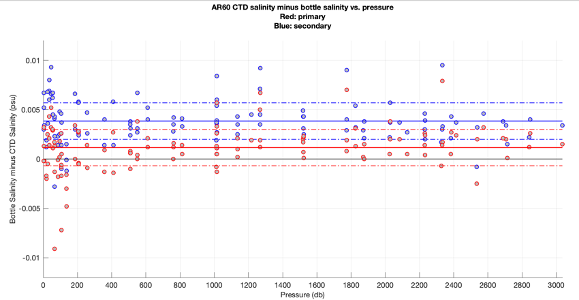
In order to apply a calibration based on the bottle data to the CTD data, I first QC’d the bottle data and then followed methods described in the GO-SHIP manual. There are several sources of error that can contribute to incorrect salinity bottle values, ranging from poor sample collection technique to an accidental salt crystal dropping into a sample just before being run on a salinometer. This is why all methods of CTD calibration using bottle data stress the importance of using many bottle values in a statistical grouping. However, sometimes there are “fly-away” values that are so far gone they don’t contribute meaningful information to the statistics, and in those cases I simply disregard those values. As a reference, for the Irminger 8 cruise I threw out 9 of the ~125 salinity samples collected before proceeding with calibration methods. Note that within the methods described in the above documentation, systematics approaches are used to further control for outlier or “bad” bottle values.
Figure 2
Since the majority of CTD stations for OOI are performed close to one another (and consequently in similar water masses), I grouped all stations together to characterize sensor errors. The resulting fits produced primary and secondary sensor calibrations that allow for more meaningful comparison of data with other programs. Figure 2 shows how primary and secondary data compare before and after bottle calibrations have been applied. Post calibration, primary and secondary sensors now agree more closely in terms of their differences. Similarly, Figure 3 summarizes data before and after calibration in temperature-salinity space, providing visual context for the magnitude of bottle calibration. Many folks working with CTD data would say that this is a rather small adjustment!
Figure 3
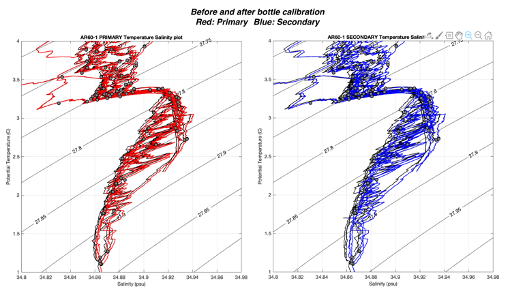
Figure 4
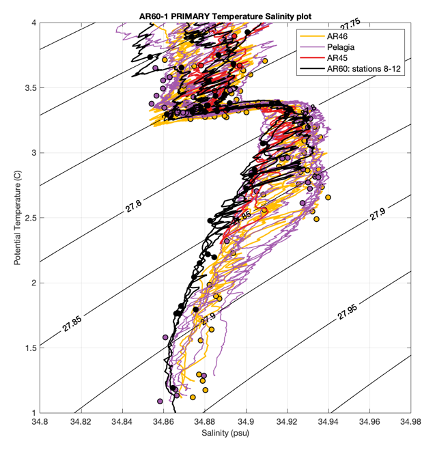 However, Figure 4 shows a comparison of the bottle-calibrated OOI data with nearby OSNAP CTD profiles from 2020. The results here are extremely important as OSNAP currently has moorings deployed near the OOI array and the OOI CTD profiles provide a midway calibration point for the moored instrumentation that is currently deployed for two years. These midway calibration CTD casts are critical in providing information on moored sensor drift and biofouling in a region where there has been a slow freshening of deep water (colder than 2.5 ºC) throughout the duration of these programs. Quantifying the rate of freshening is one of the objectives that OSNAP focuses on, but it is nearly impossible without high-quality CTD data for comparison. Figure 4 demonstrates that the freshening trend has continued from 200 to 2021 and that the bottle-calibrated OOI CTD data will be critical for interpretation of moored data.
However, Figure 4 shows a comparison of the bottle-calibrated OOI data with nearby OSNAP CTD profiles from 2020. The results here are extremely important as OSNAP currently has moorings deployed near the OOI array and the OOI CTD profiles provide a midway calibration point for the moored instrumentation that is currently deployed for two years. These midway calibration CTD casts are critical in providing information on moored sensor drift and biofouling in a region where there has been a slow freshening of deep water (colder than 2.5 ºC) throughout the duration of these programs. Quantifying the rate of freshening is one of the objectives that OSNAP focuses on, but it is nearly impossible without high-quality CTD data for comparison. Figure 4 demonstrates that the freshening trend has continued from 200 to 2021 and that the bottle-calibrated OOI CTD data will be critical for interpretation of moored data.
Finally, for those interested in the salinity-calibrated CTD dataset, please contact lmcraven@whoi.edu. A more detailed summary of the calibration applied can be found in my CTD calibration report here.
BLOGPOST #3 (August 18, 2021)
Irminger 8 science operations are now fully underway, which means the stream of CTD data is coming in hot (actually the ocean temps are very cold)! So far, CTD stations 4 through 11 correspond to work performed near the Irminger OOI array location. I spent the weekend and past couple of days paying close attention to these initial stations. Here’s an update on how things look so far.
One of the concerns this year is that the R/V Neil Armstrong is using a new CTD unit and sensor suite (new to the ship, not purchased new). Any time a ship’s instrumentation setup changes, it’s a very good idea to keep a close eye on things as changes naturally mean there’s more room for human error. What better way to talk about this than to share my own mistakes in a public blog! When I first downloaded and processed the OOI Irmginer 8 (AR60) CTD data from near the Irminger OOI array location, I became very worried…
When I compared the Irminger 8 CTD data with three cruises from the same location last year, I was seeing very confusing and unphysical data in my plots. I was using Seabird CTD processing routines in the “SBE Data Processing” software (see https://www.seabird.com/software) that I had used for previous OOI Irminger cruises as a preliminary set of scripts, so I was confident that something strange with the CTD was going on. I immediately pinged folks on the ship to ask if there was anything that they could tell was strange on their side of things. Keep in mind, this OOI cruise focuses more on mooring work with only a handful of CTDs to support all additional hydrographic work, so any time there is a potential issue with the CTD data we want to address it as soon as possible. I started digging into things a bit more, and realized that I had made a mistake.
Within the SBE processing routines, there is a module called “Align CTD”. As stated in the software manual: “Align CTD aligns parameter data in time, relative to pressure. This ensures that calculations of salinity, dissolved oxygen concentration, and other parameters are made using measurements from the same parcel of water. Typically, Align CTD is used to align temperature, conductivity, and oxygen measurements relative to pressure.” When working in areas where temperature and salinity change rapidly with pressure (depth), this module can be very important (and I encourage you to read through its documentation). As you’ll see below, the OOI Irmginer Sea Array region can see some extremely impressive temperature and salinity gradients. This has to do with the introduction of very cold and very fresh waters from near the coast of Greenland, together with the complect oceanic circulation dynamics of the region. Based on data collected on the old CTD installed on the Armstrong, I had determined that advancing conductivity by 0.5 seconds produced a more physically meaningful trace of calculated salinity.
While 0.5 seconds doesn’t seem large, it’s important to remember that most shipboard CTD packages are lowered at the SBE-recommended speed of 1 meter/second. Depending on how suddenly properties change as the CTD is lowered through the water, this magnitude of adjustment may seriously mess things up if it’s not the correct adjustment. In the case of the CTD system currently installed on the Armstrong, I’m finding that very little adjustment to conductivity is needed. There are many reasons as to why this value will change – from CTD to CTD, cruise to cruise, and even throughout a long cruise. The major factor is the speed at which water flows through the CTD plumbing and sensors and how far the pressure, temperature, and conductivity sensors are from each other in the plumbed line. Water flow is controlled by many things including CTD pump performance, contamination in the CTD plumbing, kinks in the CTD pluming lines, etc. (for more information, start here: https://www.go-ship.org/Manual/McTaggart_et_al_CTD.pdf and here: file:///Users/leah/Downloads/manual-Seassoft_DataProcessing_7.26.8-3.pdf. Note that the SBE data processing manual provides great tips on how to choose values for the Align CTD module.
Below is a figure that summarizes impact on my processed data before and after my mistake. This is a fun figure as it compares CTD data from four cruises that all completed CTDs near the OOI site: the 2020 OSNAP Cape Farewell cruise (AR45), the 2020 OOI Irminger 7 cruise (AR46), a 2020 cruise on R/V Pelagia from the Netherlands Institute for Sea Research, and stations 5-7 of the 2021 OOI Irminger 8 cruise (AR60). I’m plotting the data in what is called temperature-salinity space. This allows scientists to consider water properties while being mindful of ocean density, which as mentioned in the last post, should always increase with depth. I include contours indicating temperature and salinity values that correspond to lines of constant density (in this case I am using potential density referenced to the surface). For data to be physically consistent, we expect that the CTD traces never loop back across any of the density contours. These figures are also incredibly useful as the previous three cruises in the region give us some understanding of what to expect from repeated measurements near the Irminger OOI array.
The plot on the left shows the data processed with a conductivity advance of 0.5 sec. As you can see, the CTD traces appear much noisier than the other datasets, and contain many crossings of the density contours (i.e., density inversions). The plot on the right shows data that are smoother and less problematic in terms of density. You may also note that in the right plot, the AR60 traces are a bit shifted to the left in salinity (i.e. fresher or lower salinity values) when compared to the other datasets. This is because I am plotting bottle-calibrated CTD data from the other three cruises. Just as I type this, I’ve been given word that the shipboard hydrographer has begun analyzing salinity water sample data for Irminger 8. These bottle data are critical for applying a final adjustment to CTD salinity data and I’ll talk more about this in a future post.
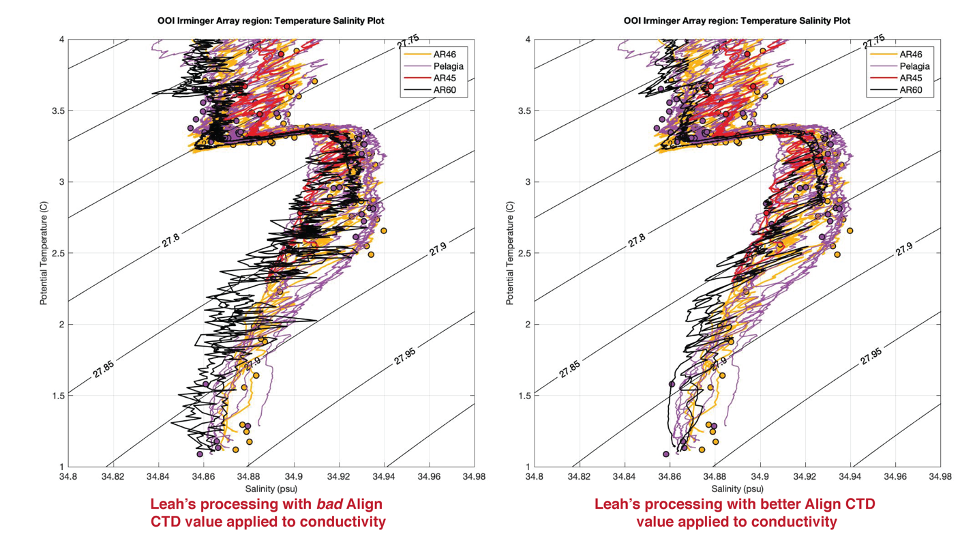
For now, I’m happy to report that the data look physically consistent! For completeness, I include the core CTD parameter difference plots from stations 4 through 11 (CTDs completed near the array thus far). CTD difference plots are described in my previous post. All checks out from where I am sitting so far. Thanks to the CTD watch standers and shipboard technicians for working so hard and taking good care of the system while the cruise is underway!
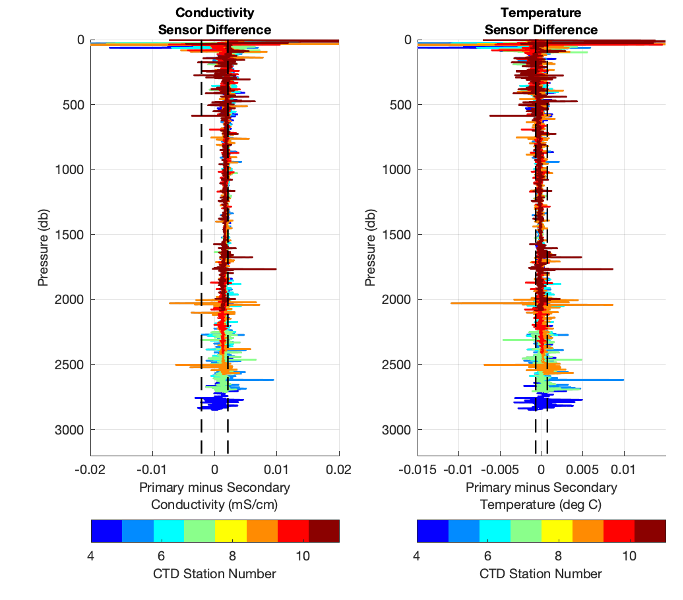
BLOGPOST #2 (August 10, 2021)
For this post I’d like to introduce some of the tools that folks can use to identify CTD issues and sensor health while at sea. Most of what I’ll be discussing here is specific to the SBE911 system that is commonly used on UNOLS vessels; however, a lot of these topics are relevant to other types of profiling CTD systems.
There are several end case users of CTD data within science. These include people who perform CTDs along a track and complete what we call a hydrographic section (useful in studying ocean currents and water masses); those who perform CTDs at the same location year after year to look for changes; people who use CTDs to calibrate instrumentation on other platforms (moorings, gliders, AUVs, etc.); and those who use the CTD to collect seawater for laboratory analysis (collected samples can be used to further analyze physical, chemical, biological, and even geological properties!). For each of these CTD uses, a core set of CTD parameters are needed.
Core CTD parameters include pressure, temperature, and conductivity. Conductivity is used together with pressure and temperature measurements to derive salinity. These three variables are needed to give users the critical information of depth and density in which water samples are collected, and support the calculation of additional variables. For example, ocean pressure, temperature, and salinity together with a voltage from an oxygen sensor are needed to derive a value for dissolved oxygen. In addition to core CTD parameters, it is very common to add dissolved oxygen, fluorescence, turbidity, and photosynthetically active radiation (PAR) sensors to a shipboard CTD unit. Each of these additional measurements have errors that must be propagated from the core CTD measurements – creating a rather complex system to navigate when trying to understand the final accuracy of a given measurement.
For each CTD data application, varying degrees of accuracy are needed from the measured CTD parameters to accomplish the scientific objective at hand… And this is where a lot of folks get into trouble! For a first example, consider someone who would like to calibrate a nitrate sensor that is deployed for a year on a mooring using water samples collected from the CTD. For a second example, consider someone who is interested in the changing dissolved oxygen content of deep Atlantic Meridional Overturning Circulation waters. In both cases, the core CTD parameters are critical. In the first example, this person needs to know the pressure and ocean density at the exact location their water samples are collected during a CTD cast so they can correctly associate analyzed water sample values with the correct position of the sensor on the mooring. However, in the second example, this person may need to use both salinity and oxygen samples to improve the accuracy and precision of CTD measurements so that their final data product will be sensitive enough to resolve small, but potentially critical, changes in the ocean.The most important take away here (CTD soapbox moment!) is that even if end users are not specifically interested in studying physical oceanographic parameters, they still need tools to verify that 1) the core CTD measurements are of high enough quality for use in their application and 2) that there are no unnecessary errors from the core measurements that are impacting their ability to address their scientific objective.
This is the first reason why I heavily encourage all CTD end users to become familiar not only with the accuracy of their particular measured parameter, but also the core CTD parameters. The second reason is that core CTD parameters are particularly useful in diagnosing early warning signs of CTD problems. Most shipboard systems install primary and secondary temperature and conductivity sensors on their CTDs, which provide an opportunity for in-situ sensor comparison. Additionally, calculated seawater density is particularly useful as it is one of the few properties we can make a strong assumption about – it should always increase with pressure. The density of seawater is determined by pressure, temperature, and salinity (conductivity), hence any time one or some of these recorded values is suspect, non-physical density “inversions” or “noise” may appear in the data record.
Below are two figures that can be very helpful in diagnosing CTD problems. In these examples, I am using the Irminger 8 (AR60-01) deep test cast, which took place late Sunday evening, August 8th. Figure 1 shows difference plots of the two sensor pairs (temperature and conductivity). Each panel includes vertical dashed lines indicating expected manufacturer agreement ranges (see sensor specification sheets datasheet-04-Jun15.pdf and datasheet-03plus-May15.pdf). The values shown are, ±(2 x 0.001 ºC) and ±(2 x 0.003 mS/cm) for temperature and conductivity sensors, respectively (note that 0.003 mS/cm is close to 0.003 psu for reasonable temperature ranges). In general, sensor differences should fall within, or very close to, this range when calibrated by the manufacturer within the past year. The rule can be relaxed in the upper water column, however, differences between sensors deeper than approximately 500 m that consistently fall outside of this range indicate problematic sensor drift or contamination. Figure 2 shows the calculated seawater density profile using the primary sensors. Consistent density inversions larger than ~0.1 kg/m3 also indicate problematic sensor drift or contamination. When creating such figures, always look at the downcast and upcast (skipped here for the sake of brevity). The upcast will look a bit worse than the downcast (I encourage you to read about why), but those data are extremely important to anyone collecting water samples!
Figure 1
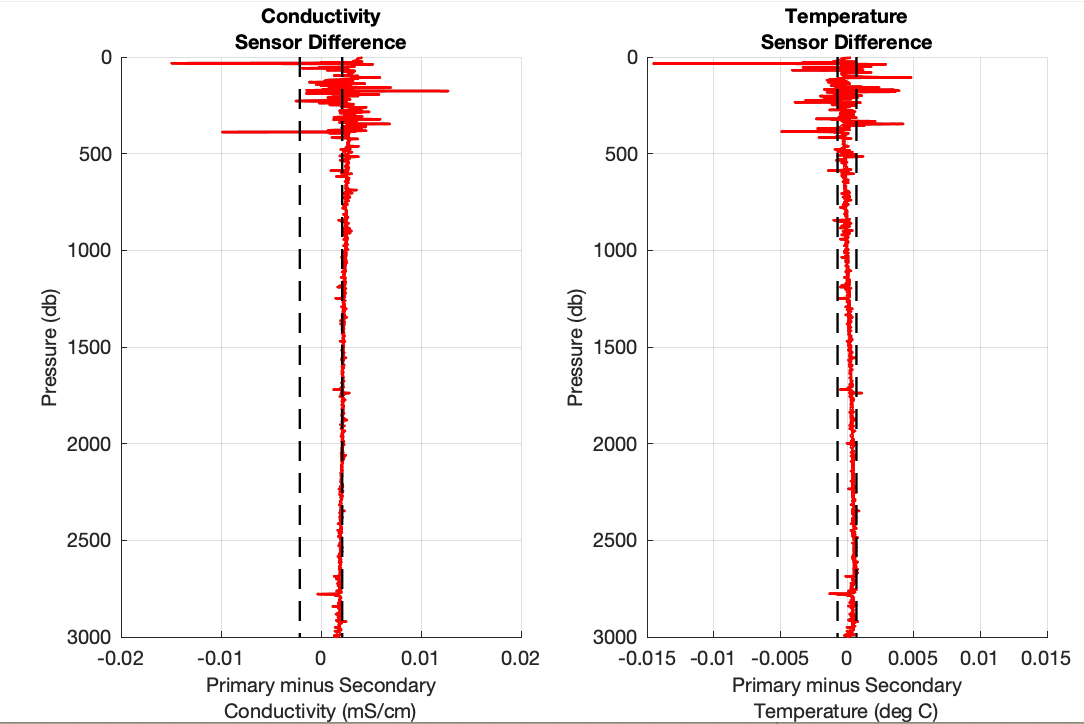
Figure 2
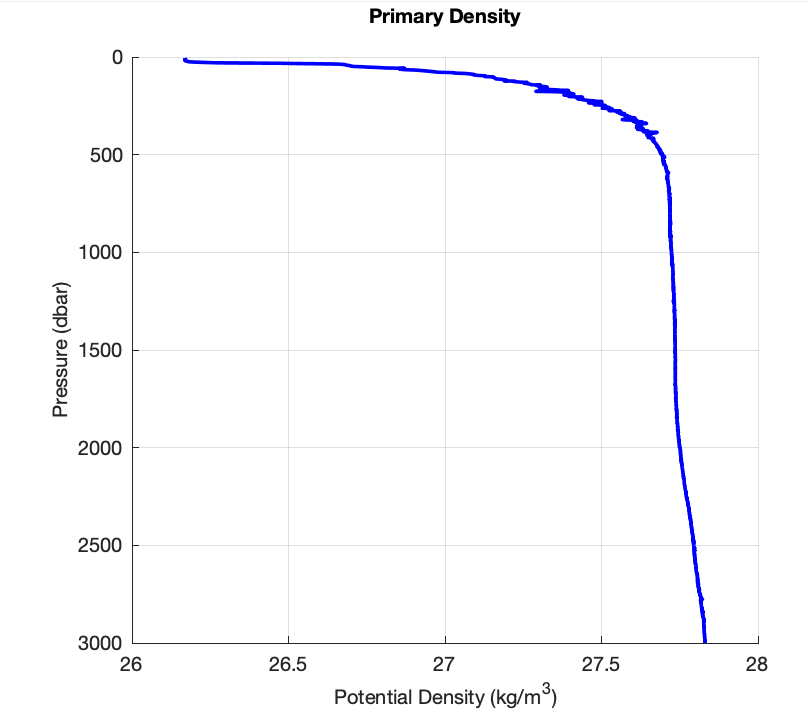
So, what can these plots tell us about the CTD system implemented on the Irminger 8 cruise so far? Figure 1 demonstrates an overall acceptable level of agreement between the sensor pairs. The particular sensors in use right now have calibrations older than one year, so this level of agreement is actually quite good. Figure 2 is also rather promising in showing a density profile that is continuously increasing. If you’re being picky (like me), you may notice that there are some small density inversions between roughly 200-500 m. After taking a closer look, I noted that the salinity profile indicates that there are some rather impressive salinity intrusions evident in the upper 500 meters (I encourage you to download data from cast 2 and verify!). This is normal for the Labrador Sea region where the cast took place (lots of melting ice nearby) and will naturally create a bit more “noise” in these plots. So, I’m not very concerned by this.
Now what do these plots look like when there’s a problem? There unfortunately isn’t one simple answer for this (I’ve been doing this for over ten years and am still learning subtle ways CTDs show problems!), but I’ll share two examples of when something was clearly wrong. The first example is from the Irminger 7 cruise (AR35-05). Figure 3 and Figure 4 show our two plots for stations 1-13 of the Irminger 7 cruise. Figure 3 shows a suspiciously large offset (well outside of the general threshold we expect in the conductivity differences) and incredibly noisy differences in both conductivity and temperature. Similarly, Figure 5 shows consistent and large density inversions for some of these casts. Several of the casts shown in Figures 4 and 5 were so bad that there are no usable profiles as far as scientific objectives are concerned. Luckily, however, there were a few casts in the set that could be corrected with water sample data (I’ll talk more about this later). Data loss is something that does happen while at sea, and the Irminger Sea in particular is an incredibly harsh environment to work in. However, if folks are diligent in creating these plots while at sea, the hope is that we can minimize time and data loss while striving for the highest quality data possible.
Figure 3
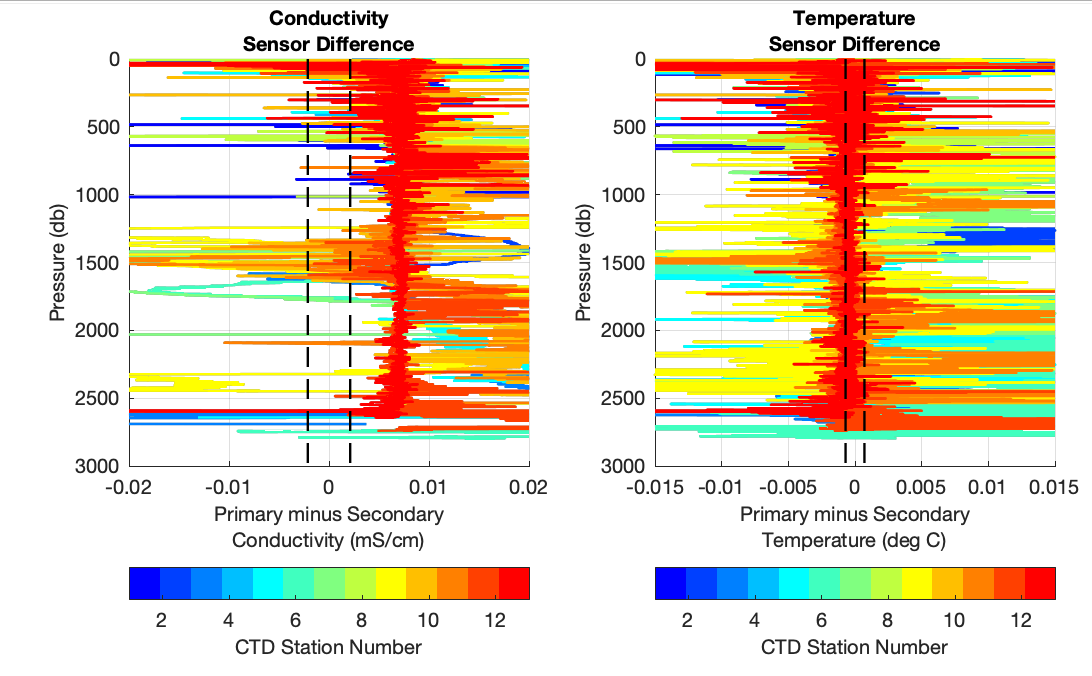
Figure 4
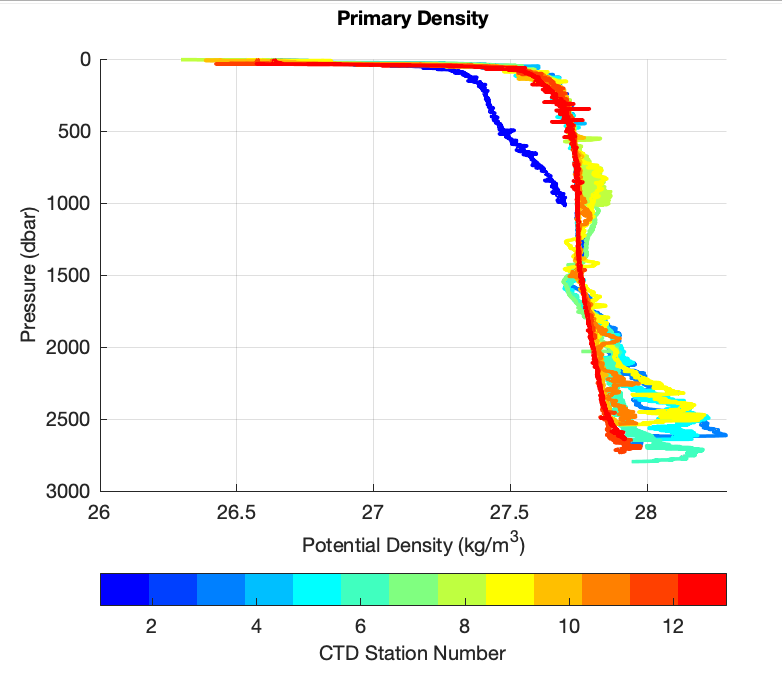
For my last example, I provide a quick reference guide for how core CTD parameter issues may look on a Seabird CTD Real-Time Data Acquisition Software (Seasave) screen. The reason for this is that a lot of people don’t have time to create fancy plots while at sea, so it’s helpful to know how to approach monitoring while watching the data come in. Follow the link here to download a one-page pdf that can be displayed next to your CTD acquisition computer.
BLOG POST #1 (August 2, 2021)
[caption id="attachment_21736" align="aligncenter" width="2560"]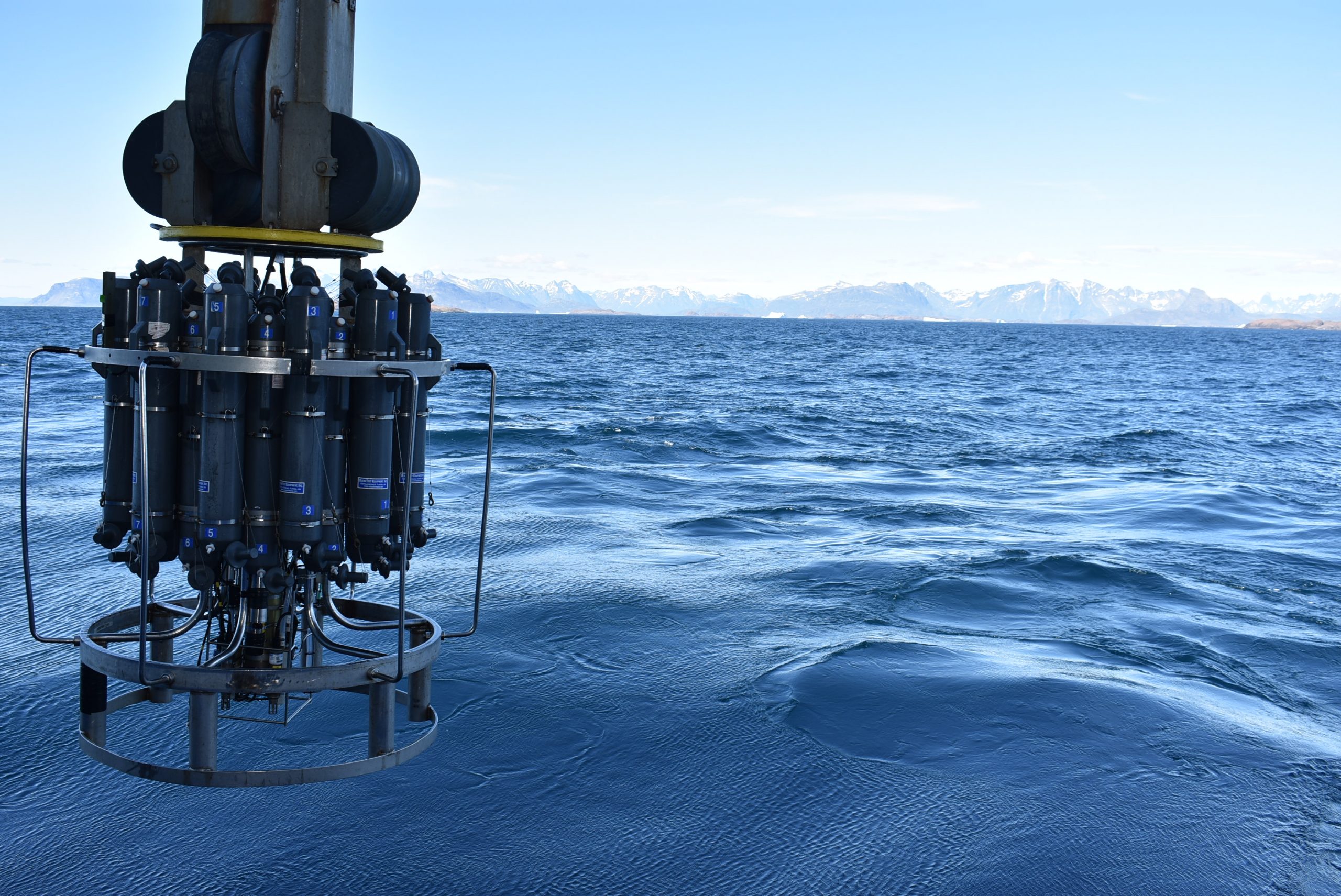 A CTD is performed near the coast of Greenland during one of the OSNAP 2020 cruises on R/V Armstrong. Photo: Isabela Le Bras©WHOI[/caption]
A CTD is performed near the coast of Greenland during one of the OSNAP 2020 cruises on R/V Armstrong. Photo: Isabela Le Bras©WHOI[/caption]
Hello folks and welcome to the Irminger 8 CTD blog! As the cruise progresses, tune in here for updates on Irminger 8 CTD data quality as well as tips on how best to approach using OOI CTD data. I plan to keep this information inclusive for folks with varying levels of experience with shipboard CTD data – from beginner to expert! If you have any questions about CTD data, feel free to send me an email (lmcraven@whoi.edu) and I’ll do my best to help. For this first post, I would like to summarize some important resources available to the community that will greatly help with CTD data acquisition and processing.
CTDs have been around for a while, which on the surface makes them a bit less interesting than many of the new exciting technologies used at sea. The fact remains that the CTD produces some of the most accurate and reliable measurements of our ocean’s physical, chemical, and biological parameters. Aside from being very useful on their own, CTD data serve as a standard by which researchers can compare and validate sensor performance from other platforms: gliders, floats, moorings, etc. Sensor comparison is particularly important for instruments that are deployed in the ocean for a long time (as is the case for OOI assets) as it is normal for sensors to drift due to environmental exposure and biological activity. As it turns out, CTD data provide a backbone for all OOI objectives.
[caption id="attachment_21739" align="alignleft" width="450"]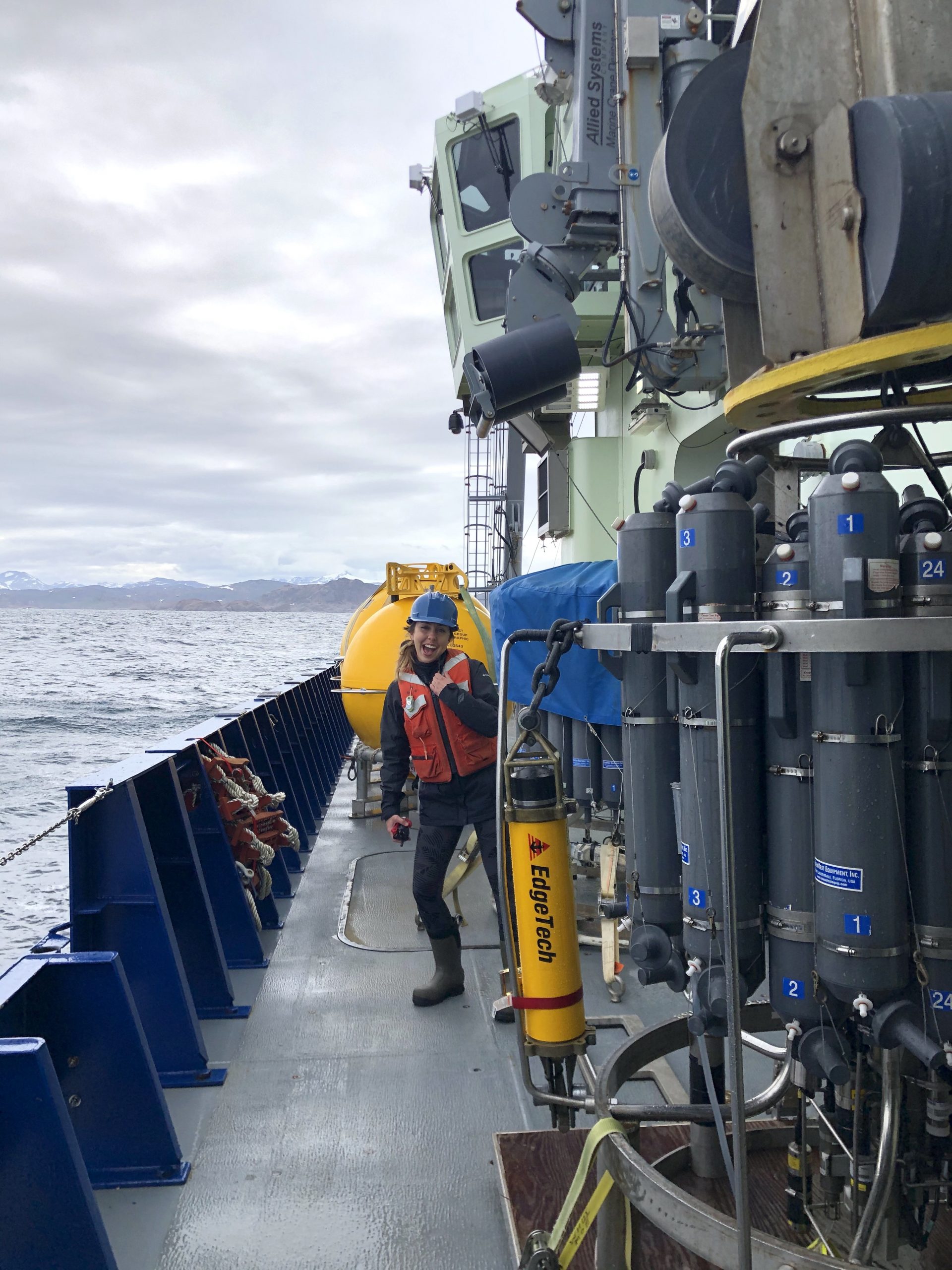 Leah McRaven helps to deploy a CTD during one of the OSNAP 2020 cruises on R/V Armstrong. Photo: Astrid Pacini, MIT/WHOI Joint Program[/caption]
Leah McRaven helps to deploy a CTD during one of the OSNAP 2020 cruises on R/V Armstrong. Photo: Astrid Pacini, MIT/WHOI Joint Program[/caption]
However, just because CTDs have been performed for decades, we can’t always assume that that collection of quality data is straightforward. For example, one of the unique challenges of collecting CTD data near the OOI Irminger site and Greenland region is that there is an elevated level of biological activity throughout the year. While biological activity is exciting for many researchers, it can clog instrument plumbing, build up on sensors, and just be plain annoying to watch out for. CTDs utilized in the Irminger Sea are also subject to extreme conditions such as cold windchills and rough sea state (Cape Farewell is actually the windiest place on the ocean’s surface!), leading to the potential for accelerated sensor drift and the need to send sensors back to manufacturers for more regular servicing and calibration. As one can imagine, there are a lot of potential sources of error when simply considering the environment that OOI Irminger CTD data are collected in.
To help combat some of these potential sources of error, I’ll be picking apart CTD and bottle data cast by cast to look for evidence of CTD problems during the Irminger 8 cruise. But before we can talk about unique sources of CTD data errors, it’s helpful to remember errors that can become systematic throughout the entire data arc: from instrument care, to acquisition, to data processing, and to final data application. Improving our awareness of these issues will allow all CTD data users the opportunity for more meaningful data interpretation. So before I move forward, I thought it would be important to share some of my favorite resources available on community-recommended CTD practices. I encourage folks to comb through these resources and find what might be most appropriate for your respective research objectives.
Recommended CTD resources are provided here.
Read MorePioneer Relocation Update 2021-09-29
The Pioneer Array, currently sited on the New England Shelf (NES), was conceived within OOI as a re-locatable, coastal array (OOI Science Plan, 2001; OOI Science Prospectus, 2007). At the Fall 2020 American Geophysical Union meeting, the National Science Foundation announced the start of a process for relocation of the Array. After a variety of community engagement activities and two intensive Innovations Labs, it was determined that the Pioneer Array will be relocated to the southern Middle Atlantic Bight (MAB). Existing infrastructure, with some modifications, will be utilized to create a new Array to address compelling science questions at the new site.
The OOI Program is consolidating the community input and preparing for Pioneer relocation activities. The overall effort is complex, and will span roughly 30 months. In order to provide a window for these efforts within the existing operational budget, there will be a pause in Pioneer field activities. Preliminary plans are for the final recovery of the NES Pioneer Array in the fall of 2022 and the initial deployment of the MAB Array in the spring of 2024. The figure below shows the anticipated timeline, with three main phases. Phase 1 will focus on preparatory activities, including environmental and engineering assessments, and a study of regulatory requirements. During Phase 2, the bulk of the engineering and design effort will be conducted. During Phase 3, environmental compliance and permitting will be completed, along with the preparation of the infrastructure for deployment.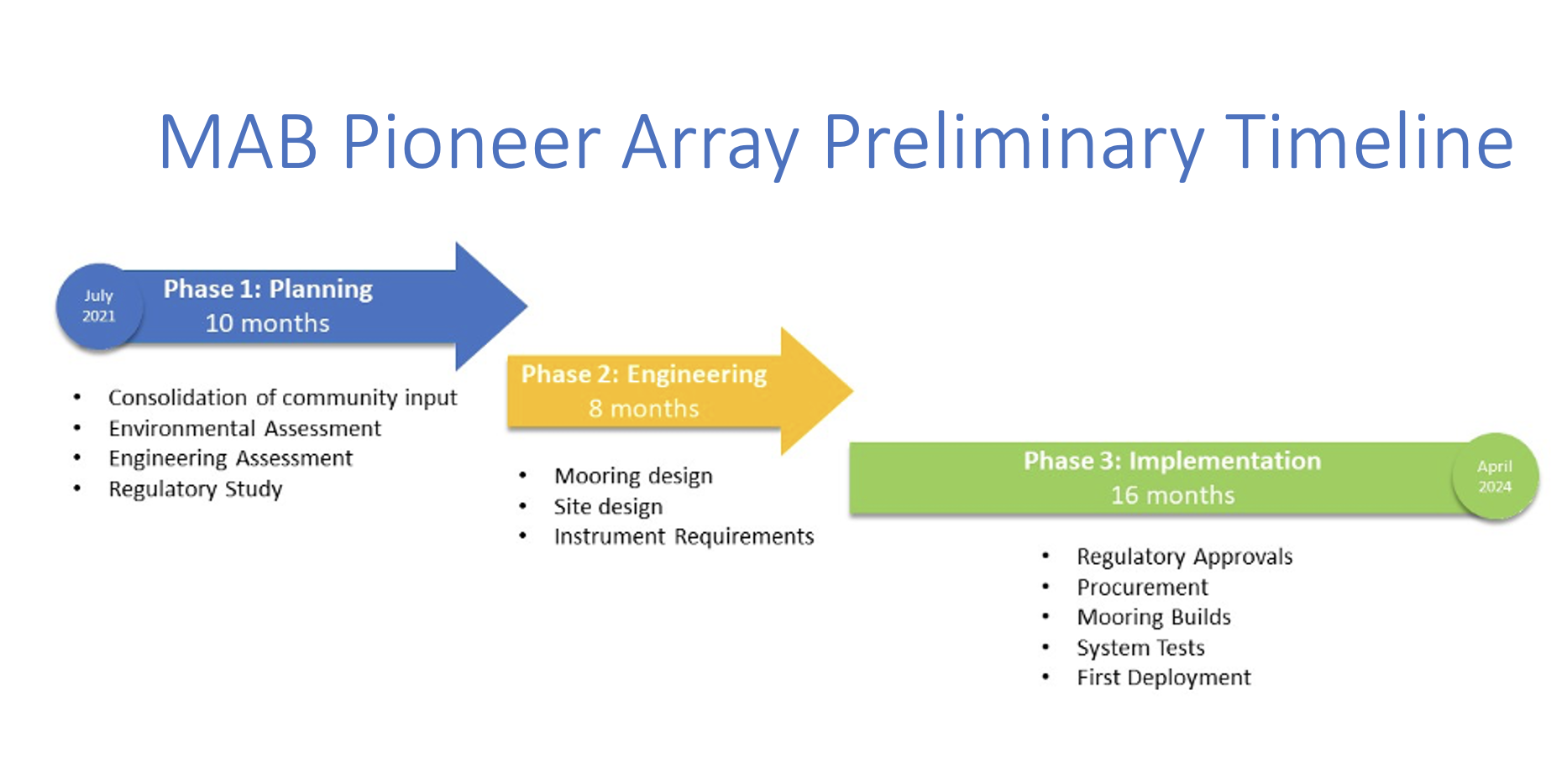
Read More
New Round of Improvements for Data Explorer
The OOI Data Team continues to listen to data users’ feedback to refine and improve Data Explorer. Many of those improvements are reflected in the latest release of Data Explorer, version 1.2, which is now operational. Data Explorer was originally released in September 2020, and this latest version is the second round of improvements made by Axiom Data Science, working with the OOI Data Team.
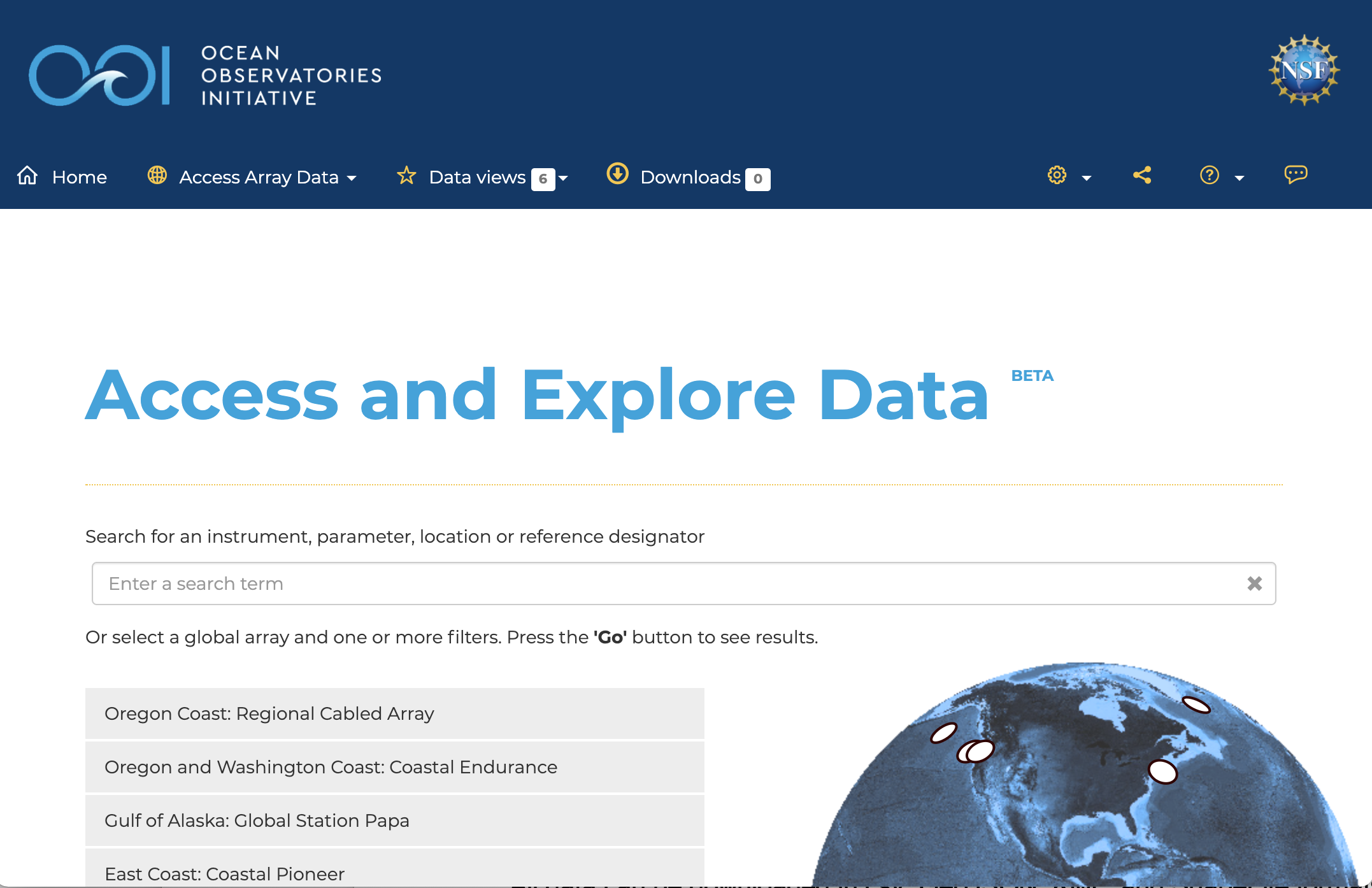
This version makes more OOI data accessible online and brings new features for gliders and profilers. It is also now possible to search for cruise data in the tabular search interface. Once there, you can select specific cruises, see their data profiles, and have a three-dimensional view of where the samples were taken. Glider data are also now available online and searchable by time and location. Once you’ve identified a glider of interest, it is possible to map or plot the glider’s route and compare data collected with data from other sensors. With another click, you can compare sensor data with profiler information, then change the parameters on the screen to learn more.
All data can be downloaded in csv, GeoJSON, KML, and ShapeFile formats for future use.
Additionally, discrete sample data (chemical analyses of seawater collected during shipboard verification sampling) have been added. Water samples are collected during OOI cruises at multiple depths, and analyzed for oxygen (Winkler), chlorophyll-a fluorescence and pigment distribution, nitrate/nitrite, and potentially a full nutrient suite, total DIC (dissolved inorganic carbon) and total alkalinity, pH, and salinity. These data can be used to compare to in situ instrument data or CTD casts in order to ensure OOI data quality. It is now possible to use Data Explorer 1.2 to convert discrete dissolved oxygen sample data from milliliters to micromoles and create standard_name mapping for discrete sample data.
In response to users’ feedback, many defects found in version 1.1 have been fixed. A summary of all the new features and bug fixes is available in the release notes.
“Data Explorer is a tool that allows users to access, manipulate, and understand OOI data for use in their research and classroom,” said Jeff Glatstein, OOI Data Delivery Lead and Senior Manager of Cyberinfrastructure. “Users’ feedback has been—and will continue to be— extremely useful in refining Data Explorer to ensure it meets users’ need and expectations. We are holding regular open meetings as one way to ensure that we receive timely feedback and work with our users to meet their needs.”
An open OOI Town Hall previewing some of the new and special glider-related features was held on 24 August 2021, where user input was welcomed. A recording of the session is available here.
Read MorePosition Opening: NSF OOI Program Director
Irminger Array Successfully Turned 8th Time
The Irminger 8 Team successfully wrapped up the eighth turn of the Global Irminger Sea Array on 26 August when the R/V Neil Armstrong docked in Reykjavik, Iceland. After a few days of demobilization, the 10 members of the science party were free to head home after showing proof of a negative COVID test 72 hours before boarding a flight back to the U.S.
Chief Scientist John Lund led the science party of 10 in completing all of the expedition’s objectives. Over the course of 26 days at sea, they recovered four moorings and deployed four new moorings in their place. The team also deployed three gliders—two Open Ocean and one Profiling—and recovered a glider that had been in the water since 2020 and whose battery supply was rapidly depleting.
[media-caption path=”https://oceanobservatories.org/wp-content/uploads/2021/08/Armstrong-and-Iceberg-e1629493552453.jpg” link=”#”]The Irminger Sea presents challenges of high winds, strong waves, and icebergs as shown here with the R/V Neil Armstrong in the foreground. Credit: drone video, Croy Carlin SSSG. [/media-caption]One highlight of the trip was engaging in scientific outreach with a class of fourth graders. The team connected with the students while out on the open ocean via Zoom. The oceanographers aboard the ship each had a chance to share what it’s like being on an oceanographic voyage and explain the purpose of the different instruments and sensors on the arrays. Another highlight of the expedition was the OOI team’s ongoing collaboration with OSNAP (Overturning in the Subpolar North Atlantic Program). While OSNAP participants were not onboard the Armstrong as in the past, their shore-based presence was clearly in evidence. Expert hydrographer Leah McRaven worked with the onboard team to adjust CTD (Conductivity, temperature, depth) sampling to ensure that new CTD equipment was calibrated and sampling properly.
The science team also added a novel twist to the regular shipboard sampling that supports field calibration and validation of the platforms and sensors in the arrays. During Irminger 8, the shipboard team worked with OOI’s onshore data team to make collected CTD data available online in near real-time. As an added bonus, McRaven shared her insights about CTD sampling in regular blog posts here.
The Irminger 8 Team took full advantage of being in this critical ocean region, which is sensitive to climate change. During transit from Woods Hole to the array, off the southeast coast of Greenland, the team deployed surface drifters and ARGO floats for the Greenland Freshwater Project, which is studying the impact of freshwater runoff from Greenland’s melting ice sheet on the North Atlantic and Arctic climate. The team also deployed a biogeochemical ARGO float for the Global Ocean Biogeochemistry Project, and took a series of CTD casts on behalf of OSNAP, to add to long term data collection efforts in this critical region. In addition, the team deployed two RAFOS floats for the Madagascar Basin Project to measure deep water circulation and 15 Sofar Spotter buoys to measure wind, wave, and temperature data.
“In the ideal, science is a collaborative process,” said Chief Scientist John Lund. “During transit time to and from the array, we were able to help our scientific partners get their equipment in the water. The data provided will help advance understanding of this critically important region, which is equally difficult to sample. The region has high winds, large, steep waves, strong currents, icebergs, and consequent equipment icing.”
Given the challenges of the ocean environment at these latitudes, the eighth turn of Irminger Array included equipment improvements. The newly deployed surface moorings included wind turbine modifications to help it withstand strong, volatile winds, and it also incorporated other structural modifications to strengthen the mooring, while easing refurbishment. Similarly, design modifications were made to the subsurface moorings to help ensure consistent, long-term data collection.
The team experienced some of these challenges of high winds and strong waves while on the cruise, but the rough conditions were compensated by the gorgeous scenery of the region. Added Lund, “One afternoon, the sun came out as the ship transited further up Prince Christian Sound. Everyone was awed by the beauty of the landscape. We saw glaciers, icebergs and the occasional whale.”
Prior to leaving the Sound, the team secured all the items for the transit to Reykjavik, the demobilization of the ship, and finally the journey home to Woods Hole.
Read More
Seaweed May Be a Solution to Faster Climate Mitigation
Scott Lindell wants to explore the potential to sequester carbon dioxide and help mitigate the climate crisis by growing seaweed and sinking it to the bottom of the Atlantic Ocean.
Lindell, a researcher at Woods Hole Oceanographic Institution, studies how marine aquaculture can be used for sustainable production of food and fuel. He started his scientific career studying fish farming, and “I’ve been working my way down the food chain ever since,” he says. With funding from the Department of Energy, Lindell’s team has already developed breeds of sugar kelp that yield four times the biomass of typical commercial production.
[media-caption path=”https://oceanobservatories.org/wp-content/uploads/2021/09/Scott-and-Dave-diving-in-Kodiak-1-scaled.jpg” link=”#”]Scott Lindell (l) and David Bailey post-dive on their demonstration kelp farm in Kodiak, AK. Credit: Domenic Manganelli[/media-caption]Seaweeds, like trees, uptake carbon dioxide and convert it into biomass. Oceanographic models predict that if humans sink that seaweed biomass to depths of 1000m or greater, then depending on microbial activity and dissolved oxygen in the water, it may take years or even decades for that carbon to break down. And, because the seaweed would be submerged at great depths, it would take centuries for that carbon to recirculate to surface water and re-equilibrate with the atmosphere.
Seaweed farming, like planting forests, could thus be a natural solution to taking carbon dioxide out of the atmosphere. But compared to planting forests, seaweed farming has the potential to scale up much more rapidly, with the added benefit of not competing for land used for farming crops.
“It would take an area on the order of twice the size of Texas and 40-50 years to create a forest that takes one gigaton of CO2 out of the atmosphere,” says Lindell. “And that forest might only store the carbon for another 40-50 years depending on forest fires, windfall, how fast the trees grow, and other factors.”
But with seaweed farming, Lindell says, “that same one gigaton removal of CO2 could be achieved by an operation as small as the state of Iowa in a year or two’s time, once the farms are developed.”
Lindell and his colleagues have already submitted proposals to study sinking kelp on the U.S. Pacific Coast, where the continental shelf drops off much faster and experiments can be done closer to shore. But he’s also interested in running experiments on the U.S. Atlantic Coast, where commercial farming of sugar kelp (Saccharina latissima) is growing rapidly.
“Our simple demonstration would be to bundle up a ton of seaweed and get it to the deepest parts of the OOI Pioneer Array, about 500 m deep. Then we’d surround it with a benthic lander equipped with cameras and sensors to monitor the rate of degradation and understand the environmental and ecosystem effects,” Lindell explains. He also plans to compare microbial activity and oxygen profile habitability in the sediments around the experimental site with those in sediments from an unimpacted site.
Lindell has started the process of user engagement with the OOI team to find ways to align these experiments with operations at the Pioneer array. “This works better if there’s already some environmental monitoring going on,” he explains. Since most seaweed farming operations on the East Coast are situated in New England waters, the area where Pioneer is currently deployed may be similar to the environments where sequestration efforts might take place.
Lindell believes it’s important to have thorough research on using seaweed as a carbon sequestration method before it becomes a larger operation.
“Iron fertilization has also been considered a climate solution, but early experiments were not carried out very carefully. That was a missed opportunity to learn more about how these solutions could work,” Lindell clarifies. “We want to get ahead of what’s become a building movement and make sure that early efforts are well monitored. We want to do it responsibly.”
Although it will take time to research and develop this carbon sequestration strategy into a commercially scalable operation, Lindell is optimistic about this method’s potential.
“We’ve got to do something,” he says. “I’m excited that this could be a short-term and expedient climate solution.”
Read More
Everything You Need to Know about CTD data
In August 2021, expert hydrographer, Leah McRaven (PO WHOI) from the US OSNAP (Overturning in the Subpolar North Atlantic Program) team, worked with the OOI team members aboard the R/V Neil Armstrong for the eighth turn of the Global Irminger Sea Array to support collection of an optimized hydrographic data product. A truly novel aspect of this collaboration was the near real-time sharing of OOI shipboard CTD data with the public. McRaven also shared her reports while the cruise is underway. In doing so, she provided a detailed explanation of the process of ensuring that CTD profiles are accurate and useable for future research use.
We share her blogs below. For archival purposes, they will also be available on the Community Tools and Datasets page.
BLOGPOST #4 (September 13, 2021)
Another OOI cruise is in the books! Now that things have wrapped up and I’ve had a chance to dig into the data a bit more thoroughly, how did we do? In my previous post I reported that the Irminger 8 CTD data looked to be very promising, but I like to include one more step before recommending data to be used for science: carefully considering salinity bottle data.
Salinity bottle data can be used in many ways to support a particular scientific objective or research question. The two that I’ve become most familiar with are 1) to support the analysis of additional bottle samples (e.g. dissolved oxygen) and 2) to provide an additional assessment and calibration of the CTD conductivity sensors. Both applications are necessary when researchers require salinity values more accurate than what CTD sensors are able to provide. However, even if this is not required, it can help ensure that users receive data that are reasonably within manufacturer specifications.
I find it easiest to consider the GO-SHIP approach to bottle data first. Using ship-based hydrography, GO-SHIP provides approximately decadal resolution of the changes in inventories of heat, freshwater, carbon, oxygen, nutrients, and transient tracers, covering the ocean basins with global measurements of the highest required accuracy to detect these changes. For a program like this, 36 salinity samples are taken every CTD station in order to provide an extremely accurate and precise calibration for the CTD sensors. Interestingly, the Irminger OOI array is bracketed by three GO-SHIP repeat transects. While GO-SHIP provides invaluable measurements, drawing a large number of samples can be expensive and time consuming. Additionally, measurements occur on a decadal timescale, so there is a lot of the picture we miss.
One of the research programs that aims to provide a higher temporal and special resolution picture of the North Atlantic is OSNAP. This program has several scientific objectives, but generally aims to quantify intra-seasonal to interannual variability of the Atlantic Meridional Overturning Circulation(AMOC) in the subpolar Atlantic. This includes a focus on heat and freshwater fluxes, pathways of currents throughout the region, and air-sea interaction, all of which require highly calibrated data products. In order to accomplish this, PIs from the program need to be able to consistently merge their shipboard and moored data products for cohesive and accurate quantification of parameters. Because much of the variability being studied is so large, researchers do not necessarily need salinity accuracies at the level of GO-SHIP, but they do need to use salinity bottle samples to ensure that CTD casts are at the very least within manufacturer specifications.
In the end, no one approach to hydrographic sampling is necessarily better than another. What is important is the delicate balance of resources while at sea that best support the scientific objectives. For both OSNAP and OOI, where the primary work at sea is focused on servicing moorings, the resources for a GO-SHIP approach to sample bottle collection is simply not feasible. However, one very key feature of the OOI CTD data is that they are collected annually, while ONSAP data are collected every two years, and GO-SHIP data are collected every ten years. Hence, OOI is able to fill in some of the temporal data gaps in the region and greatly bolster many of the international programs working in the region.
This year OOI collaborated with numerous PIs and representatives from research programs that operate in the Irminger Sea region to produce a more optimized CTD and bottle sampling strategy that better complements goals similar to GO-SHIP, as well as several additional objectives from international programs, such as OSNAP. The goal of this updated plan was to provide OOI data end users and collaborators with data that are more appropriate for CTD, mooring, glider, and float instrumentation calibration purposes. In particular, the update included increased sampling of the deep ocean. Such data are critical in the Irminger Sea region due to the uniquely large variability of temperature, salinity, and chemical properties throughout the shallow and intermediate depths of the water column. Deeper CTD and bottle data will allow all end users to more carefully reference their scientific findings to more stable water masses and allow for better intercomparison with other available datasets, such as the available GO-SHIP and OSNAP data from the region.
The majority of methods that I use when considering salinity bottle data have been adapted from GO-SHIP and NOAA/PMEL. In particular, many of the cruises I work with, including OOI, often have far fewer bottle samples than recommended by GO-SHIP or PMEL methods. This isn’t necessarily bad, since we don’t need to achieve the same goals as those programs, however, great care in adapting methods does need to be considered (and I encourage you to reach out if this is something you have an interest in). So, with the improved OOI sampling scheme, what are the potential benefits to CTD data quality?
More strategically planned salinity bottle sample collection allows users to:
- Decide if data from primary or secondary sensors are more physically consistent
- Identify times when CTD contamination was not obvious
- Assess manufacturer sensor calibrations
- Potentially provide a post-cruise calibration
In the case of the Irminger 8 cruise, I see that all four uses of salinity bottle data are possible, which will make a lot of collaborators very happy! Starting with Figure 1, we can see a summary of CTD and bottle sample salinity differences as a function of pressure for both the primary and secondary sensors. As a rule of thumb, the average offset of these differences can be considered an estimate of sensor accuracy, and the spread, or standard deviation, can be considered an estimate of sensor precision. While the data have a fairly large spread to the eye, the standard deviations (indicated by the dashed lines) are placing the spread for each sensor within what we expect from the manufacturer precision. The striking result from this figure is that before using the bottle data to further calibrate the data, we see that the primary sensor had a higher accuracy than the secondary sensor. In going back to the Seabird Electronics calibration reports for the primary and secondary sensors (available via the OOI website), I noted that the calibrations for each sensor was a bit older than what we normally work with (last performed in May 2019). Additionally, the secondary sensor had a larger correction at its time of manufacturer calibration than the primary. This is corroborated by the differing sensor accuracies as determined by the bottle data. Lastly, while there are a few spurious differences shown, on average there doesn’t look to be any CTD and bottle differences due to factors other than expected calibration drifts.
Figure 1

In order to apply a calibration based on the bottle data to the CTD data, I first QC’d the bottle data and then followed methods described in the GO-SHIP manual. There are several sources of error that can contribute to incorrect salinity bottle values, ranging from poor sample collection technique to an accidental salt crystal dropping into a sample just before being run on a salinometer. This is why all methods of CTD calibration using bottle data stress the importance of using many bottle values in a statistical grouping. However, sometimes there are “fly-away” values that are so far gone they don’t contribute meaningful information to the statistics, and in those cases I simply disregard those values. As a reference, for the Irminger 8 cruise I threw out 9 of the ~125 salinity samples collected before proceeding with calibration methods. Note that within the methods described in the above documentation, systematics approaches are used to further control for outlier or “bad” bottle values.
Figure 2
Since the majority of CTD stations for OOI are performed close to one another (and consequently in similar water masses), I grouped all stations together to characterize sensor errors. The resulting fits produced primary and secondary sensor calibrations that allow for more meaningful comparison of data with other programs. Figure 2 shows how primary and secondary data compare before and after bottle calibrations have been applied. Post calibration, primary and secondary sensors now agree more closely in terms of their differences. Similarly, Figure 3 summarizes data before and after calibration in temperature-salinity space, providing visual context for the magnitude of bottle calibration. Many folks working with CTD data would say that this is a rather small adjustment!
Figure 3

Figure 4
 However, Figure 4 shows a comparison of the bottle-calibrated OOI data with nearby OSNAP CTD profiles from 2020. The results here are extremely important as OSNAP currently has moorings deployed near the OOI array and the OOI CTD profiles provide a midway calibration point for the moored instrumentation that is currently deployed for two years. These midway calibration CTD casts are critical in providing information on moored sensor drift and biofouling in a region where there has been a slow freshening of deep water (colder than 2.5 ºC) throughout the duration of these programs. Quantifying the rate of freshening is one of the objectives that OSNAP focuses on, but it is nearly impossible without high-quality CTD data for comparison. Figure 4 demonstrates that the freshening trend has continued from 200 to 2021 and that the bottle-calibrated OOI CTD data will be critical for interpretation of moored data.
However, Figure 4 shows a comparison of the bottle-calibrated OOI data with nearby OSNAP CTD profiles from 2020. The results here are extremely important as OSNAP currently has moorings deployed near the OOI array and the OOI CTD profiles provide a midway calibration point for the moored instrumentation that is currently deployed for two years. These midway calibration CTD casts are critical in providing information on moored sensor drift and biofouling in a region where there has been a slow freshening of deep water (colder than 2.5 ºC) throughout the duration of these programs. Quantifying the rate of freshening is one of the objectives that OSNAP focuses on, but it is nearly impossible without high-quality CTD data for comparison. Figure 4 demonstrates that the freshening trend has continued from 200 to 2021 and that the bottle-calibrated OOI CTD data will be critical for interpretation of moored data.
Finally, for those interested in the salinity-calibrated CTD dataset, please be in touch (lmcraven@whoi.edu). A more detailed summary of the calibration applied can be found in my CTD calibration report here.
BLOGPOST #3 (August 18, 2021)
Irminger 8 science operations are now fully underway, which means the stream of CTD data is coming in hot (actually the ocean temps are very cold)! So far, CTD stations 4 through 11 correspond to work performed near the Irminger OOI array location. I spent the weekend and past couple of days paying close attention to these initial stations. Here’s an update on how things look so far.
One of the concerns this year is that the R/V Neil Armstrong is using a new CTD unit and sensor suite (new to the ship, not purchased new). Any time a ship’s instrumentation setup changes, it’s a very good idea to keep a close eye on things as changes naturally mean there’s more room for human error. What better way to talk about this than to share my own mistakes in a public blog! When I first downloaded and processed the OOI Irmginer 8 (AR60) CTD data from near the Irminger OOI array location, I became very worried…
When I compared the Irminger 8 CTD data with three cruises from the same location last year, I was seeing very confusing and unphysical data in my plots. I was using Seabird CTD processing routines in the “SBE Data Processing” software (see https://www.seabird.com/software) that I had used for previous OOI Irminger cruises as a preliminary set of scripts, so I was confident that something strange with the CTD was going on. I immediately pinged folks on the ship to ask if there was anything that they could tell was strange on their side of things. Keep in mind, this OOI cruise focuses more on mooring work with only a handful of CTDs to support all additional hydrographic work, so any time there is a potential issue with the CTD data we want to address it as soon as possible. I started digging into things a bit more, and realized that I had made a mistake.
Within the SBE processing routines, there is a module called “Align CTD”. As stated in the software manual: “Align CTD aligns parameter data in time, relative to pressure. This ensures that calculations of salinity, dissolved oxygen concentration, and other parameters are made using measurements from the same parcel of water. Typically, Align CTD is used to align temperature, conductivity, and oxygen measurements relative to pressure.” When working in areas where temperature and salinity change rapidly with pressure (depth), this module can be very important (and I encourage you to read through its documentation). As you’ll see below, the OOI Irmginer Sea Array region can see some extremely impressive temperature and salinity gradients. This has to do with the introduction of very cold and very fresh waters from near the coast of Greenland, together with the complect oceanic circulation dynamics of the region. Based on data collected on the old CTD installed on the Armstrong, I had determined that advancing conductivity by 0.5 seconds produced a more physically meaningful trace of calculated salinity.
While 0.5 seconds doesn’t seem large, it’s important to remember that most shipboard CTD packages are lowered at the SBE-recommended speed of 1 meter/second. Depending on how suddenly properties change as the CTD is lowered through the water, this magnitude of adjustment may seriously mess things up if it’s not the correct adjustment. In the case of the CTD system currently installed on the Armstrong, I’m finding that very little adjustment to conductivity is needed. There are many reasons as to why this value will change – from CTD to CTD, cruise to cruise, and even throughout a long cruise. The major factor is the speed at which water flows through the CTD plumbing and sensors and how far the pressure, temperature, and conductivity sensors are from each other in the plumbed line. Water flow is controlled by many things including CTD pump performance, contamination in the CTD plumbing, kinks in the CTD pluming lines, etc. (for more information, start here: https://www.go-ship.org/Manual/McTaggart_et_al_CTD.pdf and here: file:///Users/leah/Downloads/manual-Seassoft_DataProcessing_7.26.8-3.pdf). Note that the SBE data processing manual provides great tips on how to choose values for the Align CTD module.
Below is a figure that summarizes impact on my processed data before and after my mistake. This is a fun figure as it compares CTD data from four cruises that all completed CTDs near the OOI site: the 2020 OSNAP Cape Farewell cruise (AR45), the 2020 OOI Irminger 7 cruise (AR46), a 2020 cruise on R/V Pelagia from the Netherlands Institute for Sea Research, and stations 5-7 of the 2021 OOI Irminger 8 cruise (AR60). I’m plotting the data in what is called temperature-salinity space. This allows scientists to consider water properties while being mindful of ocean density, which as mentioned in the last post, should always increase with depth. I include contours indicating temperature and salinity values that correspond to lines of constant density (in this case I am using potential density referenced to the surface). For data to be physically consistent, we expect that the CTD traces never loop back across any of the density contours. These figures are also incredibly useful as the previous three cruises in the region give us some understanding of what to expect from repeated measurements near the Irminger OOI array.
The plot on the left shows the data processed with a conductivity advance of 0.5 sec. As you can see, the CTD traces appear much noisier than the other datasets, and contain many crossings of the density contours (i.e., density inversions). The plot on the right shows data that are smoother and less problematic in terms of density. You may also note that in the right plot, the AR60 traces are a bit shifted to the left in salinity (i.e. fresher or lower salinity values) when compared to the other datasets. This is because I am plotting bottle-calibrated CTD data from the other three cruises. Just as I type this, I’ve been given word that the shipboard hydrographer has begun analyzing salinity water sample data for Irminger 8. These bottle data are critical for applying a final adjustment to CTD salinity data and I’ll talk more about this in a future post.

For now, I’m happy to report that the data look physically consistent! For completeness, I include the core CTD parameter difference plots from stations 4 through 11 (CTDs completed near the array thus far). CTD difference plots are described in my previous post. All checks out from where I am sitting so far. Thanks to the CTD watch standers and shipboard technicians for working so hard and taking good care of the system while the cruise is underway!

BLOGPOST #2 (August 10, 2021)
For this post I’d like to introduce some of the tools that folks can use to identify CTD issues and sensor health while at sea. Most of what I’ll be discussing here is specific to the SBE911 system that is commonly used on UNOLS vessels; however, a lot of these topics are relevant to other types of profiling CTD systems.
There are several end case users of CTD data within science. These include people who perform CTDs along a track and complete what we call a hydrographic section (useful in studying ocean currents and water masses); those who perform CTDs at the same location year after year to look for changes; people who use CTDs to calibrate instrumentation on other platforms (moorings, gliders, AUVs, etc.); and those who use the CTD to collect seawater for laboratory analysis (collected samples can be used to further analyze physical, chemical, biological, and even geological properties!). For each of these CTD uses, a core set of CTD parameters are needed.
Core CTD parameters include pressure, temperature, and conductivity. Conductivity is used together with pressure and temperature measurements to derive salinity. These three variables are needed to give users the critical information of depth and density in which water samples are collected, and support the calculation of additional variables. For example, ocean pressure, temperature, and salinity together with a voltage from an oxygen sensor are needed to derive a value for dissolved oxygen. In addition to core CTD parameters, it is very common to add dissolved oxygen, fluorescence, turbidity, and photosynthetically active radiation (PAR) sensors to a shipboard CTD unit. Each of these additional measurements have errors that must be propagated from the core CTD measurements – creating a rather complex system to navigate when trying to understand the final accuracy of a given measurement.
For each CTD data application, varying degrees of accuracy are needed from the measured CTD parameters to accomplish the scientific objective at hand… And this is where a lot of folks get into trouble! For a first example, consider someone who would like to calibrate a nitrate sensor that is deployed for a year on a mooring using water samples collected from the CTD. For a second example, consider someone who is interested in the changing dissolved oxygen content of deep Atlantic Meridional Overturning Circulation waters. In both cases, the core CTD parameters are critical. In the first example, this person needs to know the pressure and ocean density at the exact location their water samples are collected during a CTD cast so they can correctly associate analyzed water sample values with the correct position of the sensor on the mooring. However, in the second example, this person may need to use both salinity and oxygen samples to improve the accuracy and precision of CTD measurements so that their final data product will be sensitive enough to resolve small, but potentially critical, changes in the ocean.The most important take away here (CTD soapbox moment!) is that even if end users are not specifically interested in studying physical oceanographic parameters, they still need tools to verify that 1) the core CTD measurements are of high enough quality for use in their application and 2) that there are no unnecessary errors from the core measurements that are impacting their ability to address their scientific objective.
This is the first reason why I heavily encourage all CTD end users to become familiar not only with the accuracy of their particular measured parameter, but also the core CTD parameters. The second reason is that core CTD parameters are particularly useful in diagnosing early warning signs of CTD problems. Most shipboard systems install primary and secondary temperature and conductivity sensors on their CTDs, which provide an opportunity for in-situ sensor comparison. Additionally, calculated seawater density is particularly useful as it is one of the few properties we can make a strong assumption about – it should always increase with pressure. The density of seawater is determined by pressure, temperature, and salinity (conductivity), hence any time one or some of these recorded values is suspect, non-physical density “inversions” or “noise” may appear in the data record.
Below are two figures that can be very helpful in diagnosing CTD problems. In these examples, I am using the Irminger 8 (AR60-01) deep test cast, which took place late Sunday evening, August 8th. Figure 1 shows difference plots of the two sensor pairs (temperature and conductivity). Each panel includes vertical dashed lines indicating expected manufacturer agreement ranges (see sensor specification sheets datasheet-04-Jun15.pdf and datasheet-03plus-May15.pdf). The values shown are, ±(2 x 0.001 ºC) and ±(2 x 0.003 mS/cm) for temperature and conductivity sensors, respectively (note that 0.003 mS/cm is close to 0.003 psu for reasonable temperature ranges). In general, sensor differences should fall within, or very close to, this range when calibrated by the manufacturer within the past year. The rule can be relaxed in the upper water column, however, differences between sensors deeper than approximately 500 m that consistently fall outside of this range indicate problematic sensor drift or contamination. Figure 2 shows the calculated seawater density profile using the primary sensors. Consistent density inversions larger than ~0.1 kg/m3 also indicate problematic sensor drift or contamination. When creating such figures, always look at the downcast and upcast (skipped here for the sake of brevity). The upcast will look a bit worse than the downcast (I encourage you to read about why), but those data are extremely important to anyone collecting water samples!
Figure 1

Figure 2

So, what can these plots tell us about the CTD system implemented on the Irminger 8 cruise so far? Figure 1 demonstrates an overall acceptable level of agreement between the sensor pairs. The particular sensors in use right now have calibrations older than one year, so this level of agreement is actually quite good. Figure 2 is also rather promising in showing a density profile that is continuously increasing. If you’re being picky (like me), you may notice that there are some small density inversions between roughly 200-500 m. After taking a closer look, I noted that the salinity profile indicates that there are some rather impressive salinity intrusions evident in the upper 500 meters (I encourage you to download data from cast 2 and verify!). This is normal for the Labrador Sea region where the cast took place (lots of melting ice nearby) and will naturally create a bit more “noise” in these plots. So, I’m not very concerned by this.
Now what do these plots look like when there’s a problem? There unfortunately isn’t one simple answer for this (I’ve been doing this for over ten years and am still learning subtle ways CTDs show problems!), but I’ll share two examples of when something was clearly wrong. The first example is from the Irminger 7 cruise (AR35-05). Figure 3 and Figure 4 show our two plots for stations 1-13 of the Irminger 7 cruise. Figure 3 shows a suspiciously large offset (well outside of the general threshold we expect in the conductivity differences) and incredibly noisy differences in both conductivity and temperature. Similarly, Figure 5 shows consistent and large density inversions for some of these casts. Several of the casts shown in Figures 4 and 5 were so bad that there are no usable profiles as far as scientific objectives are concerned. Luckily, however, there were a few casts in the set that could be corrected with water sample data (I’ll talk more about this later). Data loss is something that does happen while at sea, and the Irminger Sea in particular is an incredibly harsh environment to work in. However, if folks are diligent in creating these plots while at sea, the hope is that we can minimize time and data loss while striving for the highest quality data possible.
Figure 3

Figure 4

For my last example, I provide a quick reference guide for how core CTD parameter issues may look on a Seabird CTD Real-Time Data Acquisition Software (Seasave) screen. The reason for this is that a lot of people don’t have time to create fancy plots while at sea, so it’s helpful to know how to approach monitoring while watching the data come in. Follow the link here to download a one-page pdf that can be displayed next to your CTD acquisition computer.
BLOG POST #1 (August 2, 2021)
[caption id="attachment_21736" align="aligncenter" width="2560"] A CTD is performed near the coast of Greenland during one of the OSNAP 2020 cruises on R/V Armstrong. Photo: Isabela Le Bras©WHOI[/caption]
A CTD is performed near the coast of Greenland during one of the OSNAP 2020 cruises on R/V Armstrong. Photo: Isabela Le Bras©WHOI[/caption]
Hello folks and welcome to the Irminger 8 CTD blog! As the cruise progresses, tune in here for updates on Irminger 8 CTD data quality as well as tips on how best to approach using OOI CTD data. I plan to keep this information inclusive for folks with varying levels of experience with shipboard CTD data – from beginner to expert! If you have any questions about CTD data, feel free to send me an email (lmcraven@whoi.edu) and I’ll do my best to help. For this first post, I would like to summarize some important resources available to the community that will greatly help with CTD data acquisition and processing.
CTDs have been around for a while, which on the surface makes them a bit less interesting than many of the new exciting technologies used at sea. The fact remains that the CTD produces some of the most accurate and reliable measurements of our ocean’s physical, chemical, and biological parameters. Aside from being very useful on their own, CTD data serve as a standard by which researchers can compare and validate sensor performance from other platforms: gliders, floats, moorings, etc. Sensor comparison is particularly important for instruments that are deployed in the ocean for a long time (as is the case for OOI assets) as it is normal for sensors to drift due to environmental exposure and biological activity. As it turns out, CTD data provide a backbone for all OOI objectives.
However, just because CTDs have been performed for decades, we can’t always assume that that collection of quality data is straightforward. For example, one of the unique challenges of collecting CTD data near the OOI Irminger site and Greenland region is that there is an elevated level of biological activity throughout the year. While biological activity is exciting for many researchers, it can clog instrument plumbing, build up on sensors, and just be plain annoying to watch out for. CTDs utilized in the Irminger Sea are also subject to extreme conditions such as cold windchills and rough sea state (Cape Farewell is actually the windiest place on the ocean’s surface!), leading to the potential for accelerated sensor drift and the need to send sensors back to manufacturers for more regular servicing and calibration. As one can imagine, there are a lot of potential sources of error when simply considering the environment that OOI Irminger CTD data are collected in.
To help combat some of these potential sources of error, I’ll be picking apart CTD and bottle data cast by cast to look for evidence of CTD problems during the Irminger 8 cruise. But before we can talk about unique sources of CTD data errors, it’s helpful to remember errors that can become systematic throughout the entire data arc: from instrument care, to acquisition, to data processing, and to final data application. Improving our awareness of these issues will allow all CTD data users the opportunity for more meaningful data interpretation. So before I move forward, I thought it would be important to share some of my favorite resources available on community-recommended CTD practices. I encourage folks to comb through these resources and find what might be most appropriate for your respective research objectives.
Recommended CTD resources are provided here.
Read More
CGSN Infrastructure and Operations Webinar
In case you missed it, here’s another chance to join the leaders of the Coastal and Global Scale Node (CGSN) team to hear them describe the infrastructure making up the CGSN arrays, the current status of deployment, and how researchers and educators can get involved with the OOI.
[embed]https://vimeo.com/607455613[/embed] Read More

